April 27, 2008
Bruckner: Symphony no. 8 in C minor, WAB 108 (1890 [Second Version])
While a number of fine sound recordings exist to convey the aural images of the work, live performances of Bruckner’s Eighth Symphony convey the dynamic elements of the score, as conductor interacts with his players to bring out the various elements of this powerful work. Among the recent DVD releases is a compelling performance of this work led by Kent Nagano. In fact, this video appears under the label “Kent Nagano Conducts Classical Masterpieces,” the Arthaus Musik has issued on DVD series of six concerts of essential works, which include Mozart’s Symphony no. 41 “Jupiter”, Beethoven’s Symphony no. 3 “Eroica”, Schumann’s Symphony no. 3 “Rhenish”, Brahms’ Symphony no. 4, and Richard Strauss’s "Alpine" Symphony, an well-chosen group of pieces that deserve such attention.
The recording is based on a broadcast from German television, which results in high-resolution images typical of the European idiom. With clear details, from the shadows caused by the lighting on the stage to the grain of the wood in the violins and other string instruments, the recording conveys a sense of immediacy. Beyond such a technical feature, the images also show Nagano clearly, as he brings the players together in this complex and demanding score. While the film captures his conducting well enough, a series like this would benefit from an inset of a camera trained on the conductor, so that it would be possible to view Nagano between the times when the camera currently shows him directly. Caught sometimes mid-phrase, and even then perhaps en route to a crescendo or diminuendo, the suddenly view of the conductor seems abrupt, but is certainly not unwelcome. That kind of mixture of images, a convention with DVDs of concert performances, can function, at times, at odds, with the musical line. While these kinds of shots sometimes intrude upon the performance, they can be effective in certain passages of the Finale.
As to the performance itself, the Orchestra has given a memorable reading of Bruckner’s score, with a rich, full sound, and remarkable ensemble. The brass are strong without resorting to stentorian tactics, and the chorale-like passages wonderfully resonant. Likewise, the woodwinds work well together, with the resulting precision bringing the score to sonic life. Percussion with Bruckner sometimes serve a supportive role, but with the Finale, the timpani are prominent and lead the ensemble in conveying the driving rhythms that are essential to the movement. In fact, all the forces of the Deutsches Symphonie Orchester come together with conviction in a powerful reading of the concluding movement in which Nagano demonstrates his mastery of the score. Dramatic without pandering to cliché, thunderous without playing for sheer volume, the Finale works well in Nagano’s hands, and it summarizes, in a sense, his efforts in bringing this work into the series of masterpieces that are the subject of the DVD recordings.
In addition to this performance of Bruckner’s Eighth Symphony, the DVD includes a documentary about the work, and at approximately 52 minutes – over half the length of the performance, it is a substantial part of the recording. While the documentary concerns the Symphony featured on this DVD, its label as part five, suggests some relationship to the four recordings that precede it in the set. Yet the film stands alone, and serves as an introduction to those who are unfamiliar with Bruckner in general and who might want some background about the music performed in the concert. This presentation involves some lengthy segments from the concert itself and involves imagines of familiar Bruckner iconography, along with some nature shots. It is intriguing that the producer used animation (led by Martin Mißfeldt and Gerhard Hahn) to depict some quotations from primary sources. Yet the excerpts from the rehearsals, including interviews with performers, help to support the performance recorded on this DVD. Overall, though, the documentary functions well as a pedagogical tool for this work, as the others similarly support the other pieces featured in Nagano’s series of “Masterpieces” of orchestral literature. It is a welcome addition to the concerts available on DVD and a fine performance that merits attention outside the set of Classical Masterpieces.
James L. Zychowicz
image=http://www.operatoday.com/Bruckner8_Nangano.png
image_description=Anton Bruckner: Symphony no. 8 in C minor, WAB 108 (1890 [Second Version]).
product=yes
product_title=Anton Bruckner: Symphony no. 8 in C minor, WAB 108 (1890 [Second Version]).
product_by=Deutsches Symphonie-Orchestra Berlin, Kent Nagano, conductor.DW-TV Deutsche Welle.
product_id=Arthaus Musik DVD 101 435 [DVD]
price=$19.98
product_url=http://www.arkivmusic.com/classical/album.jsp?album_id=176221
MASSENET: Chérubin
Music composed by Jules Massenet. Libretto by Henri Cain and Francis de Croisset after the latter’s play.
First Performance: 14 February 1905, Monte Carlo Opéra.
| Principal Characters: | |
| Chérubin | Soprano |
| L´Ensoieillad | Soprano |
| Nina | Soprano |
| La Comtesse | Soprano |
| La Baronne | Mezzo-Soprano |
| Le Philosophe | Bass or Baritone |
| Le Compte | Baritone |
| Le Duc | Tenor |
| Le Baron | Baritone |
| Le Capitaine Ricardo | Tenor |
| L´Hôtelier | Baritone |
| Un officier (très grand) | Bass |
Massenet´s comedy explores the love affairs of Cherubino, the amorous page of The Marriage of Figaro, the second play in the Beaumarchais Figaro trilogy. The title-rôle was designed for Mary Garden, Debussy´s first Mélisande.
[Source: Naxos]
Click here for the complete libretto.
image=http://www.operatoday.com/graham_susan.png image_description=Susan Graham audio=yes first_audio_name=Jules Massenet: Chérubin first_audio_link=http://www.operatoday.com/Cherubin.m3u product=yes product_title=Jules Massenet: Chérubin product_by=Susan Graham (Chérubin)Robert Lloyd (Le Philosophe)
Maria Bayo (L´Ensoleillad)
Angela Gheorghiu (Nina)
Gerard Quinn (Count)
Jane Leslie Mackenzie (Countess)
Peter Savidge (Baron)
Fiona Kimm (Baroness)
Ryland Davies (Duke)
Gordon Wilson (Ricardo)
Gordon Sandison (Innkeeper)
Bryan Secombe (Officer)
Royal Opera House, Covent Garden, Mario Bernardi
Live broadcast, 24 February 1994, London
April 25, 2008
Satyagraha at the MET
The piece is not a music-drama, an enactment of a story by singers using musical means to express their emotions. Instead of an impersonated text, the characters enact scenes from Gandhi’s early struggles to invent and apply his philosophy of pacific resistance to tyranny while singing/chanting gnomic phrases from the ancient Hindu scripture, the Bhagavad Gita.
For another matter, vocal art is – how to put this? – not in the forefront in this musical stage piece, though the duet performed by Maria Zifchak and Ellie Dehn in Act III, evolving into an ensemble as Gandhi leads his followers in a triumphant march for striking coal miners, is as gorgeous a piece of sheer vocal sound as the Met has presented all season. Richard Croft, who from his years as an early music tenor (renowned for his limpid Handel) has learned how to fill a simple line with subtle emotion, playing Gandhi made the feeling of enlightened, undramatic mystery both accessible and moving – which I think is what the composer wished to achieve (and failed to achieve, to my mind, in his Akhnaton). These performances are not “operatic” except in the sense that they come from “characters” and sing without microphones, but they thrill the ear for all that.
Philip Glass’s “opera” is more of an oratorio, but not even that, for the text does not pretend to tell any kind of stage-story. The Gita texts are illustrated by symbolic dioramas of six scenes from the early life of Mahatma Gandhi, plus, as prologue, the most famous scene from the Gita itself, and mimed moments in the lives of three contemporaries who influenced or were influenced by Gandhi: Leo Tolstoy, Rabindranath Tagore and Martin Luther King. The scenes presented take place in British South Africa before World War I.There Gandhi developed a philosophy and a following for peaceful resistance to oppression before he took this message home to India, whose liberation he was ultimately instrumental in effecting.
In this extraordinary production by Phelim McDermott to designs by Julian Crouch with lighting by Paule Constable the use of multimedia from modern and ancient sources (puppets, shadows, processions, stilts, aerial stunts, projections, moving projections), has been carefully calculated. Movement and design exquisitely accompanied the musical and dramatic presentation, which demonstrates in its cumulative power the effect of synchronized musical, dramatic and stage structure into one concentrated act of storytelling.
This marks a painful contrast, for example, to the Met’s stagings of Lucia and Peter Grimes earlier this season, where the directors (unaccustomed to opera and unfamiliar with the works they were handling) seemed perversely determined to defy and contradict the dramatic intentions of the creators, to use their stage smarts to frustrate the telling of the tales. Perhaps because of the difficulty Satyagraha would have appealing to any traditional opera house audience if it were given perverse or slapdash treatment, or perhaps just because the composer is alive and present to protest, Satyagraha has been given a production with a care and a thoughtfulness – a concern for the work – that the Met seems unwilling to lavish upon more standard fare.
Newspapers, a frequent trope, represent an example of the sort of metaphor the staging devised to place us in Gandhi’s era: Cheap newspapers were a major breakthrough of the nineteenth century, and with wire services to fill them, there was now something like an immediate world audience for the first time. Gandhi’s revolution might well have fizzled without this avenue of appeal to the “great British sense of fair play” – a thing that did not usually prevent the government from doing whatever it wanted. For the first time in history, the whole world was watching and Gandhi’s moral force was in people’s faces, not an ignorable event in some distant corner of the planet.
Building on this point, newspapers serve screens on which to read subtitles or through which to see shadow puppet shows. Newspapers are balled up as weapons hurled at Gandhi by hostile crowds, and are laid out on stage by busy followers representing, perhaps, the repetitive motions of the labor force (in fields or in factories) who were Gandhi’s audience and his constituency – and the intended beneficiaries of his work.
Special congratulations are due to chorus master Donald Palumbo (the hero, in fact, of the entire season) and to Dante Anzolini, who had the unenviable job of leading the Met orchestra used to more variation than what they play in Glass’s slow-moving and repetitious score, and accomplished this with great success.
The score itself builds upon the usual Glass arpeggios, the repetitiousness that makes each intrusion a fascinating relief. In a Glass score, melody, like text, has been discarded as an expressive tool – and I, for one, deeply regret the fact that melody has ceased to speak to much of the contemporary audience, or anyway to contemporary composers of opera.
What Glass has replaced these things with does not serve the traditional purposes of opera, and so we must examine what purpose an “opera” now has. He relies on rhythm, and he makes tremendous – sometimes excessive – use of it, for instance to express the hieratically slow progress of the peace movement. Then, there is a tremendously effective moment near the end of Act I when the regular four-square rhythm we have grown used to abruptly lurches into a syncopated beat to suggest the turbulence created by Gandhi in his acquiescent society – a traditional trick, and I was grateful for the hint of something comprehensible in Glass’s method.
At the end of Act II, I was also much amused when Gandhi’s followers threw their identity cards into a pit and brought in a torch to set them on fire. Glass, evidently unable to find a way of setting such a moment in his personal stylebook, fell back on illustrating flames in a manner that would have been familiar to Tchaikowsky (in The Maid of Orleans ) or Verdi (Otello), never mind Wagner. Glass renounces expressiveness, but when he finds he needs it, he has to go back to the classics to steal it. It is like the very young couple next door sneering at your old-fashioned notions of haute cuisine and then coming by to borrow a cup of sugar. Refined, unhealthy – and necessary to bake an operatic cake.
The crowd in the (packed) house on April 14 seemed, many of them, new to the labyrinthine Met. They were not sure where the rest rooms or café bars were located when they all rushed for coffee at the intermissions. I (having caffeinated before the performance) enjoyed a flute of champagne to mellow out. The lines seemed unusually short. The house was filled, as it is on all the best nights, with the buzz of conversation debating the performance – from the old and puzzled to the young and disputatious. This may be further evidence that Satyagraha does not appeal to, and on acquaintance does not produce, the sort of excitement favored by the usual opera lover. But that there is a passionate market for it cannot be doubted. Is that market best served by luring it to the Met? Will they return for opera-as-usual or will they insist on this standard of production, to the point of downgrading star singing?
Satyagraha, by whatever fortunate combination of forces, under whatever conjunction of stars, is a magnificent night at the opera.
John Yohalem
image=http://www.operatoday.com/SATYAGRAHA_Act_II_scene_Cro.png image_description=A scene from Act II of Philip Glass's "Satyagraha" with Richard Croft as Gandhi. Photo: Ken Howard/Metropolitan Opera product=yes product_title=Philip Glass: SatyagrahaMetropolitan Opera. Performance of April 14. product_by=M.K. Gandhi: Richard Croft; Miss Schlesen: Rachelle Durkin; Mrs. Naidoo: Ellie Dehn; Kasturbai Gandhi: Maria Zifchak; Mr. Kallenbach: Earle Patriarco: Parsi Rustomji: Alfred Walker; Mrs. Alexander: Mary Phillips; Prince Arjuna: Bradley Garvin; Lord Krishna: Richard Bernstein. Conducted by Dante Anzolini. product_id=Above: A scene from Act II of Philip Glass's "Satyagraha" with Richard Croft as Gandhi.
Photo: Ken Howard/Metropolitan Opera
April 23, 2008
Sarasota rises above the regional
These, however, are concepts given new dimensions by the four operas on stage this spring in Sarasota’s newly remodeled 1200-seat theater.
DeRenzi is no friend of Regieoper, the approach to opera that gives the director full freedom to ignore the original time and place of a work — and the intentions of the composer. At Sarasota Opera, for example,you will never see Handel’s “Julius Caesar” set at the Cairo Hilton,where Peter Sellars once located it to great acclaim. That does not mean,however, that DeRenzi is a man stuck in an bygone age. His concern is for fidelity to opera and for authenticity and integrity in SO stagings.
Much research and study go into each production to make it reflect its time in history. Every effort is made to offer an honest presentation of a composer intentions. All this came to the fore in the season’s “I due Foscari,” which was part of two major SO projects. It continued the Verdi cycle designed to perform the composer’s entire oeuvre — operatic, vocal and instrumental — in Sarasota.
Launched in 1989 by DeRenzi, a Verdi scholar in his off hours, the cycle includes alternate of versions of scores when they exist. It will conclude in2013 to celebrate the 200th anniversary of the composer’s birth.“Foscari” is also part of DeRenzi’s “Masterworks Revival Series,” which brings to the SO stage long-neglected works that the director considers of artist merit. The series, begun in 1989, has included such rarities on the American stage as Catalani’s “La Wally,” “Königskinder” by Humperdinck and Rimsky-Korsakov’s “May Night.”
Given the quality of the SO “Foscari,” directed by Martha Collins, the neglect of the 1844 score is difficult to understand. The opera, the well-focused and touchingly sad story of a wronged father and son, is without the complexities that often make Verdi’s plot line hard to follow. With DeRenzi on the podium, the April 6 performance moved with edge-of-the-seat excitement through three hours of full-blooded choruses — several of them for men alone.
Italian baritone Marco Nistico brought dramatic intensity to octogenarian Doge Franceso Foscari, while Benjamin Warschawski sang his passionate song with an energetic voice that, however, lacked the support that a good teacher should have given the Swiss tenor. As devoted wife, mother and daughter-in-law Panamanian soprano Reyna Carguill bore the sufferings of Lucrezia Contarini with regal dignity. Jeffrey W. Dean’s sets were of classic simplicity, and costumes by Howard Tsvi Kaplan brought the richness of primary colors to the staging.
That one knows of Puccini’s “La Rondine” at all is due to the popularity of the aria “Il bel sogno di Doretta,” a favorite of singers from Kiri Te Kanawa to Renee Fleming. And a pity that is, for the entire work, performed as lovingly as it was at the SO April 5 matinée, is an experience of heightened sensuous beauty. Some devaluate the sumptuous score as operetta, for in the directness of its emotional appeal it follows in the footsteps of Vienna’s fin-de-sie`cle masters. And the reference to Vienna is indeed valid, for Puccini had been asked to write “a comic opera like‘Der Rosenkavalier,’ but more amusing and more organic.” Whether“ Rondine” amuses the individual can decide, but the work is organic in that is well organized and tightly written. Nothing in it is superfluous.
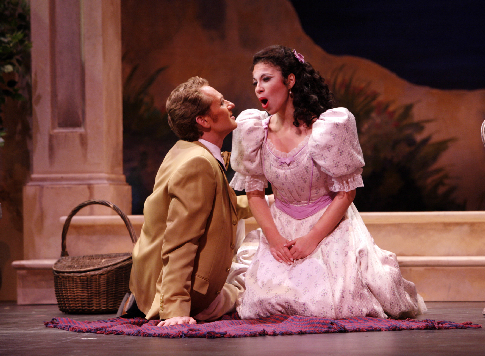 Ryan MacPherson as Ruggero and Lina Tetruashvili as Magda (Photo by Richard Termine courtesy of Sarasota Opera)
Ryan MacPherson as Ruggero and Lina Tetruashvili as Magda (Photo by Richard Termine courtesy of Sarasota Opera)
Georgian soprano Lina Tetruashvili, who headed the cast as Magda, was perhaps the top star of the entire ’08 SO season. A young woman of gentle beauty, she was equally convincing as the successful courtesan and as a woman experiencing great love for the first time. As both she was painfully vulnerable, and her delivery of the first-act confessional self-confrontation competed favorably with recordings by established divas. Tenor Ryan MacPherson was a perfect blend of spoiled mama’s boy and unwritten page as a Ruggero who was a perfect partner for Tetrusashvili. As the second couple in the story Christina Bouras sang the maid Lisette with ironic detachment and a sense of good humor about the fools that mortals can be. But the true hero of the afternoon was David Neely, a young conductor whose career centers in Germany. Neely obviously believes in this score and in his surrender to its beauty made a fine case for its greatness.
The scenery and costumes that evoke the time and place of each SO production were particularly noteworthy in the second act of “Rondine.” A café of the Belle Époque was designed to perfection by Michael Schweikardt.An abundance of glass walls and ceilings, some decorated with sprays of flowers, made visible groups of round lights and a gray cityscape outside. References to the posters of the period by Alphonse Mucha and Toulouse-Lautrec provided a perfect ambiance for chance meetings and revelry.
Sometimes called “a poor man’s ‘Traviata’” because of parallels in plot, director Michael Unger proved that “La Rondine” is anything but;it is an opera to be taken seriously for its own merits. One hopes that the excellence of the SO staging will lead other companies to consider the work.
It is probably a good thing that Mozart’s “Cosí fan tutte” lists as a comic opera, for — considered in the cold light of day — this opera offers a picture of man — and woman — that in its brutal frankness is of a shocking cruelty that would otherwise ban it from the stage. (Indeed, one left the matinée performance on April 6 recalling the admonition from Georg Büchner’s drama “Woyzeck:” “Humans, you are sand, dust and filth —how dare you pretend to be more?”) Small wonder then that it took “Cosí” well over a century to find its way into the repertory. Fortunately, Mozart conceals his view on human frailty beneath the surface of music irresistible in its charm and élan, and Sarasota was fortunate in having as it conductor Pacien Mazzagatti, a youthful American who understands both dimensions of the work.
New Yorker Mazzagatti had cast and orchestra on such short leash that it was almost impossible for the audience to applaud at the end of arias. This practice should spread to operas everywhere, for it was astonishing to seethe continuity and dramatic structure that there is in Mozart when the music is not continuously interrupted by listeners overly eager to show their appreciation. Director Pat Diamond had an ideal quartet at his disposal:Marie Adele McArthur (Fiordiligi), Vanessa Cariddi (Dorabella), Sean Anderson (Gugglielmo) and Chad A. Johnson (Ferrando). Young, good looking and secure in their roles, the four easily kept pace with Mazzagatti’s animated approach to the score. Stephen Eisenhard was a worldly Alfonso without the Mephistophelean overlay often encountered elsewhere these days, but it was Alice Bernesche who really made things move as a bright and witty Despina. David P. Gordon’s airy sets permitted spoke almost fragrantly of the land where lemons blossom and allowed for quick changes by stage hands also in costumes by Howard Tsvi Kaplan.
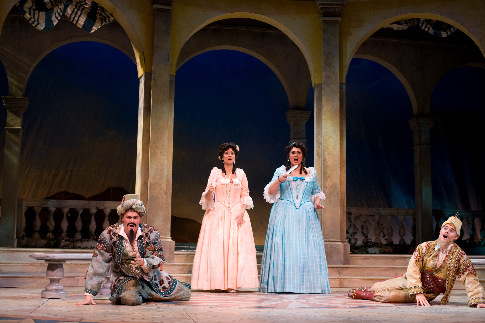 Sean Anderson as Guglielmo, Vanessa Cariddi as Dorabella, Marie-Adele McArthur as Fiordiligi, and Chad A. Johnson as Ferrando (Photo by Danielle Rappaport courtesy of Sarasota Opera)
Sean Anderson as Guglielmo, Vanessa Cariddi as Dorabella, Marie-Adele McArthur as Fiordiligi, and Chad A. Johnson as Ferrando (Photo by Danielle Rappaport courtesy of Sarasota Opera)
“Rigoletto” is something of a signature opera in Sarasota. In 1989 DeRenzi launched his Verdi Cycle with the 1851 work and he chose it to reopen the company’s renovated Mediterranean Revival theater this season. (The project cost $20 million.) It is thus surprising that it fell below the standard of excellence and excitement set by the other three works on SO stage this season. Michael Corvino kept the jester’s unsavory side in check to emerge as a truly tragic figure. However, Rafael Dávita sang — and played — the Duke with all the markings of a provincial tenor, and as Gilda Erica Strauss failed to catch fire. Impressive singing came from those in minor roles: Jeffrey Tucker (Sparafucile), studio artist Blythe Gaissert (Maddalena) and Jonathan Carle (Monterone). DeRenzi’s conducting was neither inspired nor inspiring. Stephanie Sundine directed; designer was David P. Gordan, and costumes by Howard Tsvi Kaplan. “Cosí” was a revival of the 2002 staging; the three other productions were new this season.
Although Saratoga packs its 33 performances — plus several programs staged by its apprentices — into a seven week March/April season, the company is an active presence on the Florida arts scene throughout the year.From August through April the SO musical staff works with three Youth Opera Choruses that enroll members beginning at age eight. They stage formal concerts in various venues in the city and appear also in hospitals, senior residences and nursing homes. The ensembles have participated in Italy’s International Choral Festival in Tuscany. As soon as the main season ends, work begins on the annual Youth Opera Production that stages works expressly written for children and young adults.
On stage in May this year is Canadian composer Dean Burry’s “The Hobbit,” a work based on J.R.R. Tolkien’s classic novel that was premiered to critical acclaim by Toronto’s Canadian Children’s Opera in 2004. Saratoga presents the American premiere of the work at performances slated for May 9 and 10. And SO has commissioned America’s senior music master Ned Rorem to compose a new work for 2009 based on Winsor Mcay’s comic strip “Little Nemo in Slumberland.” The libretto is being written by J.D. McClatchy. Members of the Youth Opera Choruses work with SO’s professional staff as supernumeraries and — when required — in children’s roles and choruses in mainstage productions.
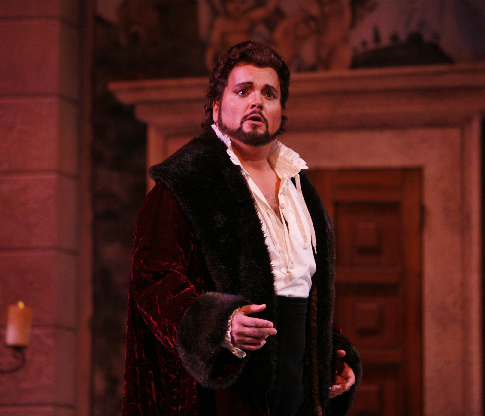 Rafael Dávila as the Duke of Mantua (Photo by Richard Termine courtesy of Sarasota Opera)
Rafael Dávila as the Duke of Mantua (Photo by Richard Termine courtesy of Sarasota Opera)
Sarasota, with a population of 300,000, is — like much of Florida — primarily a retirement community. It is relatively easy to find accommodations within easy walking distance of the opera, which has contributed greatly to the revitalization of the downtown area. The town is immaculately groomed, and good — and reasonably priced — restaurants abound. Public transportation, although limited largely to daylight hours, is well organized. It gets one to the famed Ringling Art Museum in only 15 minutes. The small airport is a fairy-tale realm compared to the chaos and confusion that prevails elsewhere today. A taxi to downtown is as little as $13.
An advantage of the SO main season is that on two weekends one can hear all four operas in only three days. On the other hand, it seems a shame to spend so little time in a town that offers a maximum of leisure at slow tempos.
Saratoga Opera opens its 50th anniversary season in November with “Barber of Seville.” On stage in spring 2008 are “Tosca,” “Elixir of Love,” “L’amico Fritz” and “Don Carlos.”
For information, visit www.sarasotaopera.org
Wes Blomster
image=http://www.operatoday.com/MG_0048_copy.png image_description= product=yes product_title=Sarasota Opera 2008 product_by=Above: Benjamin Warschawski as Jacopo FoscariPhoto by Richard Termine courtesy of Sarasota Opera
April 22, 2008
Atalanta at the Royal College of Music
 Richard Morrison [Times Online, 23 April 2008]
Richard Morrison [Times Online, 23 April 2008]
By all accounts Handel had a sense of humour. So I'm sure he would have been tickled by this delightful Royal College of Music production (ending the London Handel Festival) that transfers the story of the butch, boar-hunting Princess Atalanta and her clandestine quest for a worthy suitor to a 21st-century seaside resort populated by stroppy adolescents texting each other while hanging morosely round a litter bin. This is possibly the first Handel production in which a football scarf plays a central role.
Florez wows crowd at Met with 18 high Cs
 By MIKE SILVERMAN [AP, 22 April 2008]
By MIKE SILVERMAN [AP, 22 April 2008]
NEW YORK -- Rewarding a rare encore with an even rarer standing ovation in midperformance, a rapturous Metropolitan Opera audience hailed the company's beguiling new production of Donizetti's comic gem, "La Fille du Regiment" ("The Daughter of the Regiment").
No Breaks in Life, Not Even in a Fast-Food World
 By ANTHONY TOMMASINI [NY Times, 21 April 2008]
By ANTHONY TOMMASINI [NY Times, 21 April 2008]
PARIS — Gerard Mortier, the brilliant Belgian-born director of major European music festivals and opera houses, is poised to shake up the cultural scene in New York when he takes charge of the New York City Opera in 2009. A tireless champion of contemporary works and a provocative impresario with a penchant for radical productions that have alternately thrilled and scandalized audiences, Mr. Mortier has said that he is eager to take the helm of the “people’s opera,” as the City Opera has long been called.
A mountain of music
 [The Guardian, 21 April 2008]
[The Guardian, 21 April 2008]
The sloping marble roof of the Oslo opera house may be perfect for snowboarding. But, for Jonathan Glancey, the warm heart of this stunning building is just as thrilling
A Cut Too Far…..the new Giulio Cesare in Lausanne
And there was certainly vocal quality on display in all ranges at the first night of Lausanne Opera’s new production directed by Emilio Sagi, and supported by the modern instrument Chamber Orchestra of Lausanne — the latter bravely attempting if not always succeeding in adjusting to the period style under the baton (and harpsichord) of Italian Ottavio Dantone. The title role was sung by the German Andreas Scholl, Tolomeo by Frenchman Christophe Dumaux, Sesto by Max Emanuel Cencic and Nireno by Romanian Florin-Cezar Ouatu. Matching them in the quality stakes were Elena de la Merced as Cleopatra, Charlotte Hellekant as Cornelia and in the minor roles of Achilla and Curio, Riccardo Novaro and Yannis Francois gave strong support.
In a time when productions of Cesare seem two-a-penny on almost every continent, it was reassuring to see a full house at the distinctly “municipal” feeling Salle Metropole, where Lausanne Opera has temporarily decamped to during renovations of the old house. This venue has, despite its dreary appearance, some advantages for baroque opera — a relatively small space which suits the smaller voices and orchestras, and a compact stage area that is easy (and economic) to dress appropriately. And dress it Sagi and his designer Moreno certainly did, sometimes to excess when it came to the supernumeraries of slaves, soldiers and dancing girls. There were moments when the principals were in danger of being swamped by the waving arms (of both varieties) of what appeared to be the entire roster of Lausanne’s staff performers seeking reason for this week’s pay-packet. Costumes were elegant and exotic in a restrained way — black torso armour and matching flowing skirt-tunics for the Romans and long robes in white and gold for the Egyptians.
The sets were pleasing, leaning heavily on a mix of black, gold, and white, with just the right amount of generalised Egyptiana, and some creative use of veils and gauzes to both illustrate and conceal the action when required. Compared to some other recent productions both in Europe and the US, it was the sort of creation that one would be happy to meet again anytime whilst possibly forgetting in the interim.
However, what many in the audience will certainly not forget, nor forgive, was the decision to do away with the usual two intervals between the three Acts. This resulted in mass shuffling and fidgeting on the decidedly municipale seating as the end of the nearly two hour long first half drew near. Handel knew what he was doing pacing it the way he did, and despite the swingeing cuts to arias, da capos and recitative that were also imposed, it just didn’t work in this format.
Happily, the singers were of a standard that helped to assuage the discomforts. Andreas Scholl, in one of his rare appearances on the opera stage (to date he only appears to sing this role and that of Bertarido from “Rodelinda”), was back to excellent vocal form after some less happy performances on the concert stage last year. His very distinctive, almost instrumentally steely, tone was produced easily and without strain, and had moments of real beauty. He will never be an actor, but in this small- scale and busy production he wasn’t required to hold the stage or eye for any great amount of time and could concentrate on some admirable music making. Best when allowed to just stand and sing, Scholl produced a clarion Presti omai and a suitably sepulchral Alma del gran Pompeo with some nicely judged colouring. Less successful were his interactions with Elena de la Merced as Cleopatra where the sexual chemistry was non-existent, and there was an oddly perfunctory-sounding Se infiorito. However, all was redeemed when he stilled the house with an exquisitely shaped Aure, deh, per pieta in the final half.
De la Merced as Cleopatra was something of a pleasant surprise in this role, her normal stamping grounds being in the later worlds of Mozart, Verdi and Rossini. She was a little hesitant at first but soon the voice bloomed into an admirable, even feisty, Queen of the Nile offering dynamic variation and subtlety, enabling us to believe she was both enthralled by Cesare, yet still working the power game. An attractive slim woman with a strong stage presence her teasing Non disperar was deliciously shaped with some sparkling ornaments in the repeated A section, and her Piangero la sorte mia was long-breathed and desolate. By the final scenes (cruelly truncated in a way that made a nonsense of some of the libretto) she seemed to tire a little and her Da tempeste was a little laboured - but no doubt she will grow into this role if she wants to confirm it in her repertoire.
Contrasting with Scholl’s rather awkward stage presence was the young French countertenor Christophe Dumaux who took, yet again, the role of the wicked and deceitful Tolomeo, and made it his own. Despite being hampered by some silly costuming and spending too much time encased in a tall gauzed-walled sedan chair like an enraged bluebottle, his body language and dramatic sense were first rate. He rattled through the showpiece L’empio sleale with panache and the requisite temper. His vocal technique is firmly based, his tone round and centred, and if not a voice of great beauty, it is certainly one of dramatic sense and great agility. He is currently probably the Tolomeo of choice for many major houses. Sadly, much of his music was cut and, after the battle scene, we never see him again — even his death at the hands of the young Sesto is merely briefly reported. Handel intended that Sesto should avenge his father as a dramatic conclusion to the whole story we have witnessed. We missed Tolomeo’s blood on the carpet.
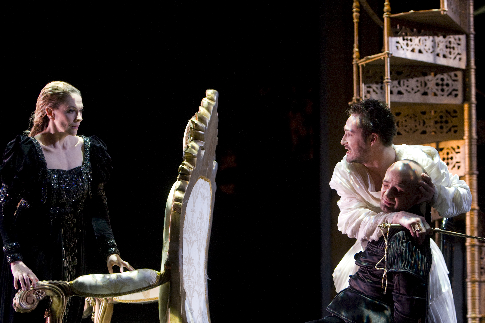 Charlotte Hellekant, Christophe Dumaux, Max Emanuel Cencic
Charlotte Hellekant, Christophe Dumaux, Max Emanuel Cencic
For some, it was the appearance of the much-publicised and promoted male soprano turned countertenor Max Emanuel Cencic, in the pivotal role of Sesto, which was the major interest of the evening — following hot on the heels of his well-received boundary-pushing CD of Rossini arias. Judging from that CD and earlier ones, this was going to be a stratospherically exciting debut in the same role that launched David Daniels to stardom at the Metropolitan nearly ten years ago. Cencic’s voice is again strong and firm-toned, extremely well-schooled, and sits somewhat higher than either Scholl or Dumaux. There was some vigorous and accurate coloratura on display, plenty of volume for this small house, and some nicely judged long lines in, for instance, the melodious Cara speme in which the very highest notes were, for some reason, feathered rather than projected. What there wasn’t, at least on the first night, was much in the way of passion or tearing agony — either vocally or physically. Most puzzling of all was his almost zombie-like non-reaction to the abuse and imprisonment of his mother Cornelia –not a flicker of emotion passing across Cencic’s face. For now, this jury is still out — finely honed recordings do not an opera star make.
The long suffering Cornelia was sung by the experienced Charlotte Hellekant who replaced the previously-billed Stephanie d’Oustrac and made as much as she could of a part that is always slightly fighting the relentless doom and gloom of her music. She is well versed in this role but on this night didn’t quite rise to the heights previously accomplished. Supporting the principals, Francois as Curio and Novaro as Achilla were more than adequate– the latter singing strongly with a nicely placed baritone and obviously a local favourite. Strangely, Achilla was allowed to keep both of his arias — a puzzle when much more lovely music was being left by the wayside.
To add insult to injury, the opera was also shorn of its final, redemptive chorus, leaving us with the inevitable feeling of: “is that all there is?” Cutting one’s coat according to one’s cloth is understandable, but not always commendable.
Sue Loder © 2008
image=http://www.operatoday.com/C_sar_4-049.png image_description=Elena de la Merced & Andreas Scholl (Photo copyright Opéra de Lausanne) product=yes product_title=G. F. Handel: Giulio CesareOpéra de Lausanne
Performance of 18 April 2008 product_by=Giulio Cesare (Andreas Scholl), Cleopatra (Elena de la Merced), Cornelia (Charlotte Hellekant), Sesto (Max Emanuel Cencic), Tolomeo (Christophe Dumaux), Achilla (Riccardo Novaro), Nireno (Florin Cezar-Ouatu), Curio (Yannis François).
Direction musicale: Ottavio Dantone
Mise en scène: Emilio Sagi
Assistant mise en scène: Curro Carreres
Orchestre de Chambre de Lausanne product_id=Above: Elena de la Merced & Andreas Scholl
All photos copyright and courtesy of Opéra de Lausanne
April 21, 2008
The Minotaur — Royal Opera, Covent Garden
The Minotaur is a man imprisoned in a non-human body with non-human desires, itself imprisoned inside a labyrinth, and his spirit is imprisoned by his inability to use human language. Ariadne is imprisoned by being physically stranded on Crete, and by the skeletons in her family’s closet. All — including the unfortunate Innocents who are delivered annually to Crete as the Minotaur’s sacrificial prey — are prisoners of fate. Birtwistle’s score is based on various permutations of a single, inescapable melodic line throughout, and Alison Chitty’s set is highly effective in its depiction of, alternately, a shoreline surrounded by a sea and sky which constantly seem to close in on one another, and a curved, claustrophobic chamber in the bowels of the labyrinth.
Although they do not realise it, everybody has much the same standing in this miserable situation. Asterios, the Minotaur, is Ariadne’s half-brother, and in the opera’s version of events he is also Theseus’s — David Harsent’s libretto has it that the Minotaur’s bull-father, rather than being a familiar of the sea-god Poseidon, was probably Poseidon himself in bull form. The denouement has the Minotaur recoiling at the sight of Theseus’s face — partly at the recognition of him as the dark shadow who, along with Ariadne, has haunted his dreams, but perhaps partly too as he recognises a human form of himself. The Oracle has said that Theseus will triumph, so we all know it is inevitable — but in the final battle, there is a moment when the two ‘brothers’ seem absolutely the equal of one another.
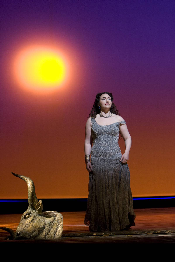 CHRISTINE RICE AS ARIADNE
CHRISTINE RICE AS ARIADNE
The piece focuses on the Minotaur far more as man than as monster, and the situation leads even the ‘complete’ humans to exhibit animalistic traits — one of the finest pieces of choreographic judgement in Langridge’s production is the moment where the First Innocent (Rebecca Bottone) finds herself flung into the presence of the Minotaur. Stalked by the creature, she skitters around the floor, legs flailing like a newborn fawn in the presence of an inescapable predator, before being raped and killed. The distinction between human and animal is less clear-cut than those outsiders who persecute the Minotaur would like to imagine.
The title role has been written for John Tomlinson, an inspired piece of dramatic visualisation on the part of the composer. Tomlinson’s singing, wordless except in the ‘dream’ scenes, is muscular and imbued with pathos, and he successfully conveys a suffering animal in his gait and stature.
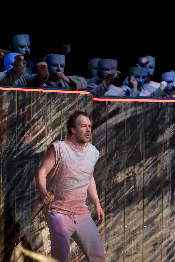 JOHAN REUTER AS THESEUS
JOHAN REUTER AS THESEUS
However, the opera at first seems to be about Ariadne, a tour de force for the mezzo Christine Rice (though the character is sketchily developed considering the length of time she spends on stage) with the focus shifting to the Minotaur and his showdown with Theseus (Johan Reuter) later on. But it matters little which way round the situation is seen, as these people are inextricably bound together. Ariadne needs Theseus in order that she can escape Crete (Theseus rejects her romantic advances, and their agreement to return to Athens together as man and wife after the Minotaur’s death is purely a business arrangement). Both Ariadne and Theseus need the Minotaur, or rather a victory over the Minotaur, as a way of defeating their own demons. The Minotaur needs Ariadne as his link with the outside world, and Theseus as his release.
The Minotaur’s only company, if it can be referred to as such, is the chorus — faceless spectators at the heart of the labyrinth, forever hungry for carnage and slaughter. They often speak in Ancient Greek, left untranslated in the surtitles, so the audience is encouraged to share the terrible isolation experienced by the Minotaur on account of his inability to use language.
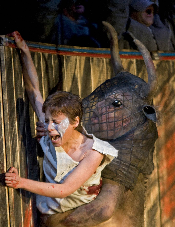 BOTTONE AS FIRST INNOCENT & TOMLINSON AS THE MINOTAUR
BOTTONE AS FIRST INNOCENT & TOMLINSON AS THE MINOTAUR
The piece is pervaded by a sense of primaeval inevitability, underlined by projected images between scenes showing a slowly rolling slate-grey sea. This creates a stasis which unfortunately has not been adequately addressed in terms of its effect on the dramatic pacing, and the need to compensate for it. The Minotaur barely moves, and is usually discovered standing still, centre stage; the length of the scenes seems determined by the amount of business that has to be got through rather than by any dramaturgical calculation. The opera’s structure seems front-heavy, with the piece’s natural centre being the extraordinary Oracle scene populated by the monstrous, androgynous Snake Goddess (countertenor Andrew Watts) and her Hiereus (Philip Langridge) who translates her incomprehensible pronouncements for Ariadne and Theseus. It is the only scene which takes place in a location other than the barren shoreline or the heart of the labyrinth, and it is where the drama takes a step forward with Ariadne’s self-revelation and the prophecy of Theseus’s success. This is in fact Scene 10 of 13. Although the slow pace does succeed in throwing into relief the faster-paced sequences, it cannot be overlooked that the opera is too long for its subject matter — the first part could be edited down by almost half, and the opera performed in a single act with the Oracle scene in the middle.
There is clumsiness in the staging, too. Killings which should be shockingly violent are trivialised by the requirement for each victim, once ‘wounded’, to run halfway off stage in order to be given a supply of stage blood to enable their wounds to look realistic. It is left to the nightmarish Keres — black-winged vulture-like harpies who feast upon the entrails of the dead and dying — to provide an injection of sheer visceral horror, scored with guttural shrieks and jagged rhythms.
With a near-perfect cast and Antonio Pappano at the musical helm, Birtwistle’s new opera could hardly have been given a better start in life. The work itself, and its promising staging, could do with a little revision if a revival is to be attempted.
Ruth Elleson © 2008
image=http://www.operatoday.com/Tomlinson_Minotaur.png image_description=John Tomlinson as the Minotaur (Photo: Bill Cooper) product=yes product_title=Harrison Birtwistle: The Minotaur product_by= The Minotaur: John TomlinsonTheseus: Johan Reuter
Ariadne: Christine Rice
Snake Priestess: Andrew Watts
Innocents: Rebecca Bottone, Pumeza Matshikiza, Wendy Dawn Thompson, Christopher Ainslie, Tim Mead
Heirus: Philip Langridge
Kere: Amanda Echalaz
The Royal Opera, Antonio Pappano (cond.)
Performance of 15 April 2008 product_id=Above: John Tomlinson as the Minotaur
All photos by Bill Cooper courtesy of The Royal Opera House
OONY Performs Puccini's Edgar
You know the bad ones, the reputedly great unknown score that, like a defective Frankenstein’s monster, refuses to come to life under her listless thunderbolt, the overparted “name” star, the clueless newbies – but there have also been great Queler nights, where a forgotten masterpiece made everybody’s eyes shine (while we wonder why on earth this is obscure), familiar singers do things you never dreamed they could do, and the unknown names are names everyone will know someday, are, well, great opera nights. Edgar was a blend of familiar (Puccini melody) and unfamiliar (but those tunes were better in other scores), with a star giving a star performance, a couple of promising youngsters, and an oldster out of depth and style but camping it up to thrill us.
Edgar is like some disreputable relation you always enjoy running into for their exuberance and oddity, and are grateful not to meet at every family party. Puccini’s second opera and first full-length effort deserves its obscurity (which is legend); one hears it nowadays mostly from a lack of anything else to scrape from the exhausted barrel of the later Italian line. (Though another association, Teatro Gratticielo, has done an impressive job resuscitating verismo works of unexpected worthiness and charm.)
The problem for Puccini – as no one knew at the time but we easily detect in hindsight – is that he didn’t quite know how to tug our heartstrings with a male protagonist. The women here are a study in contrast (goody-goody soprano, wicked, sexy mezzo), but neither has enough room, musically or dramatically, to become a living, memorable figure. Why is Tigrana such a shallow sensualist? Because she’s a Gypsy foundling? But Carmen, to take another such, has a range, an inner life, a distinctive outlook in any single act of Bizet’s opera that makes Tigrana seem an irritable child. Why is Fidelia so loving, no matter the provocation? Is it because of her name? The story takes us no deeper than that. (Again: compare Bizet’s Micaela, a fully-rounded person with a comprehensible inner life.) Puccini could make a drama out of sympathetic or unsympathetic women – but he could not (at this early stage) make one from a pair of cardboard shadows.
Therefore the outpourings of self-disgusted melody from Puccini’s protagonist (though they produce a terrific night for the right tenor, and Marcello Giordani, our best Puccini tenor nowadays, was in clover) may arouse applause but they never create interest in the outcome of this bitter little story of a man caught between a saint and a whore. The only question: will Tigrana stab herself? Or will she stab the neurotic Edgar? Or the innocent Fidelia? is not very interesting. (Which would you choose, if your objective was to shock your audience? And that was always Puccini’s aspiration.)
Queler has conducted this score before, an occasion I barely remember: it is difficult to imagine Renata Scotto sinking her teeth into Fidelia to any great degree (there’s so little meat), but Grace Bumbry surely had fun with Tigrana and we missed her on Sunday. Edgar is a lush score with verismo outpourings but also a grand concertato near the end of Act I left over from bel canto style (Puccini never wrote such a thing again) and several “ecclesiastical” numbers (vespers, a requiem) that were perfect for his family tradition.
Giordani sang with a bright, metallic sheen and an ease conspicuously lacking in his Met Ernani. It was a performance of little variety, agreeably loud (and OONY regulars like it loud), but with some interesting colors during the character’s scenes of teeth-gnash self-loathing, which include a sermon in disguise at his own funeral.
Latonia Moore, one of Queler’s stable of rising young sopranos, has a sumptuous, beautiful, crowd-pleasing voice, but it was not clear from separate, limpid, often wonderful phrases if she can put things together into a fully rounded presentation because sweet Fidelia offers such slight opportunity to do so. But the notes themselves were so wonderfully produced that one longed to hear her in more familiar repertory to see if she’s the real thing – too many ladies have fallen by the wayside in recent years as the Verdi/Puccini soprano we all long to die for.
Jennifer Larmore, alarmingly pudgy a couple of years ago, is now alarmingly rail-thin. Her acting was suitably over the top for Tigrana the heartless vamp (Theda Bara couldn’t have outplayed her), but the voice (never a Puccini-verismo voice) was not up to the role: the luscious dark colors that floored us when she first came on the scene are completely gone, and she sounded thin, overstretched, unsensuous. This role was written for a blockbuster mezzo – where was Dolora Zajick when we needed her? (Stephanie Blythe or Olga Borodina would have had fun with it, too. And all three have sung with Queler.) Larmore was all pose and gown, and she appeared to have stolen the gown from Karita Mattila’s recital wardrobe.
Stephen Gaertner, a frequent figure in concert operas and a recent Met debutante (Enrico, Melot), was impressive as Fidelia’s manic brother, Frank. “Parli il pugnale,” he and Giordani cried at one point – “Our swords will speak for us!” – when they are about to do dubious battle over Tigrana’s much contested (living) body. That tells us right there that the story is too archaic for the era Puccini lived in.
Fortunately, the swords did not do the singing.
John Yohalem
image=http://www.operatoday.com/Puccini_standing.png image_description=Giacomo Puccini product=yes product_title=Giacomo Puccini: Edgar product_by=Edgar: Marcello Giordani; Fidelia: Latonia Moore; Tigrana: Jennifer Larmore; Frank: Stephen Gaertner; conducted by Eve Queler. Opera Orchestra of New YorkPerformance of 13 April 2008
MASSENET: Marie-Magdeleine
Music composed by Jules Massenet. Libretto by Louis Gallet based on La vie de Jésus (1863) by Ernest Renan.
First performance: 11 April 1873, Théâtre de l'Odéon, Paris (concert performance).
| Principal Characters: | |
| Marie-Magdeleine (Méryem) | Mezzo-Soprano |
| Marthe | Soprano |
| Jésus | Tenor |
| Judas | Bass |
Click here for La vie de Jésus (1863) by Ernest Renan.
image=http://www.operatoday.com/Mary_Magdalene_Sandys.png image_description=Mary Magdalene by Anthony Frederick Augustus Sandys (c. 1860) audio=yes first_audio_name=Jules Massenet: Marie-Magdeleine first_audio_link=http://www.operatoday.com/marie-magdeleine2.m3u product=yes product_title=Jules Massenet: Marie-Magdeleine product_by=Jésus: Jaromír AchatziJudas: Richard Haan
Marthe: Pavlina Kambourova
Méryem: Valentina Tschavdarova
Czech Philharmonic Chorus of Brno, Brno Philharmonic Orchestra, Leoš Svárovský (cond.)
Brno, 1994
BELLINI: Norma
The video opens with an Italian tenor arriving at the opera house to sing Pollione. He is dressed in mid-20th century garb. When he turns on the speaker in his “dressing room,” we hear the familiar opening notes of Norma. Our tenor proceeds to unpack his makeup bag and to gaze happily at an opera fan magazine on which his face graces the cover. His female dresser comes in leaving the armor that he will wear on the stage as Pollione, along with some red roses that apparently have been sent to him. Others arrive and chat with him as well and, of course, they all get to see the magazine cover picture.
A large fallen tree dominates the stage, with its tall root structure resting on a shiny black floor. The older soprano arrives in all her Diva glory…..dark glasses, a fur wrap over her silver trench coat. She poses for pictures and signs autographs for her adoring fans.
Our younger singer comes in and begins to prepare to sing Adalgisa only to find a bouquet of red roses on her dressing table. It is the same bunch of flowers that our tenor had received which he left for her after removing the card. Do we begin to get the picture ….. our Italian tenor is a bit of a cad!
But this is a production of Norma and little by little our principals don at least partial period costumes as they begin to take their places in the opera. With the trappings of the modern day story always present in things like the ultra-modern looking dressing tables and racks of street clothes visible, the traditional opera unfolds.
As Pollione’s problems—his affairs with two women—inevitably come to light, we finally see Hugh Smith as Pollione and not as the Italian tenor. It took him awhile to warm up, which resulted in a strained top. But his sound improved as the performance proceeded.
Romanian-born Nelly Miricioui was cast to perform the role of Norma; however, for a variety of reasons, Hasmik Papian assumed the part on short notice. Her Casta Diva is not a show-stopper; but it nicely sets the stage for what is to come. Norma is a demanding role, which Papian performed with aplomb. She clearly understood Norma (the traditional Norma). She could be angry, remorseful, sad and regal when it was called for and seemed to move through the moods of this complicated woman with grace both vocally and as an actress.
Irini Tsirakidis, Adalgisa, was a nice surprise. New to me, Tsirakidis brought this character to life. Adalgisa is in the most impossible position, with her challenging role being both musically and dramatically interesting. It is important to me that this role work well for this opera to achieve its full dramatic impact.
Giorgio Giuseppini as Orovesco was a bit woolly and wobbly. Nevertheless, this fit his character as an elderly gentleman. And, of course, he does not have much to do other than stand around and sing.
Carol Bosi as Flavio performed well, although the part is little more than window dressing. His presence is only necessary so Pollione can talk about his women problems but not much else. Bosi possesses a pretty sounding instrument.
So the tale moves on to its sad ending when Norma and Pollione are to die together by mutual consent. The scene is beautifully sung by all. As Norma and Pollione are about to walk into the fire, they are back in their Italian tenor and aging soprano clothes. Why? Who knows. Instead of going off with Norma, Pollione takes one last step back toward Adalgisa. But Norma proceeds to walk off stage to her plight and the curtain comes down. Strange….yes. Are we supposed to think that he might not follow Norma?
If you are interested in this DVD I suggest viewing the introduction on Disc 1 first. The discussion by the stage director and conductor Julian Reynolds makes all the difference in attempting to understand what they were trying to do with this bel canto masterpiece.
Norma stands alone for me. It does not need updating or additions to sustain it. But this is not an uninteresting reading of Bellini’s work. I wonder how he might have felt about such a production.
Cheryl Dowden
image=http://www.operatoday.com/Norma_OA0959D.png image_description=Vincenzo Bellini: Norma product=yes product_title=Vincenzo Bellini: Norma product_by=Hasmik Papian, Hugh Smith, Irini Tsirakidis, Giorgio Giuseppini, Anna Steiger, Carlo Bosi, Netherlands Chamber Orchestra, Chorus of De Nederlandse Opera. Julian Reynolds, conductor. Guy Joosten, stage director. product_id=Opus Arte OA0959D [2DVDs] price=$39.98 product_url=http://www.arkivmusic.com/classical/Drilldown?name_id1=888&name_role1=1&comp_id=7408&genre=33&bcorder=195&label_id=4585Berlin’s “other” opera often stellar
But there’s much that makes the company, housed in an 1890’s variety venue in downtown Behrensstrasse, unique — and exciting. And for those who know the KO it’s not at all surprising that in 2007 Opernwelt, Germany’s leading opera journal, singled out the KO as the country’s “Opera House of the Year.”
To appreciate the KO fully, one needs to know a bit about the history of the company that dates back to a production of Fledermaus launched on December 23, 1947. Of the four victors in the war against Nazi Germany, it was the Russians who took culture most seriously; and they made a great effort to make their half of occupied Berlin a showcase for culture. Perhaps their shrewdest move was appointing Walter Felsenstein the founding director of the KO.
As an Austrian Felsenstein was viewed officially as a man from a country that had been a victim of Hitler (forget those photos of exuberant crowds welcoming the Führer to Vienna in 1938!). And not even a pro-forma communist he lived in a better district of West Berlin and even after the Wall was built in 1961 he drove his Mercedes to work. Pre-Wall West Berliners — especially students — flocked to the KO, which balanced Bertolt Brecht’s Berliner Ensemble just minutes away as a site of artistic adventure and experimentation. Nonetheless, although Felsenstein remainder in charge of the KO until his death in 1975, the brilliance of the company diminished. After the Wall was built in the West it was considered politically incorrect to pay 30 marks merely to enter the East, where the government was increasingly hard-pressed to come up with the hard currency that Felsenstein needed to make things shine at the KO. And following the founder’s death Götz Friedrich, his major assistant and seeming heir apparent, managed to move to West Berlin, where he eventually ran the Deutsche Oper for two decades.
The new chief of the KO was Harry Kupfer, who — although he had had no direct association with Felsenstein — ran the company with some distinction even after the two Germanys were united. Kupfer’s successor is Andreas Homoki. A still youthful man, Berlin — and Kupfer — trained, Homoki distinguished himself as a director throughout Europe before being named to the KO position in 2004. Limited only by the ever-increasing budget problems that plague Germany’s capital, Homoki has taken obvious advantage of the freedom that now goes with his position to honor the Felsenstein heritage that once distinguished the KO. It was Felsenstein, after all, who — although he did not coin the word — introduced the concept of Regieoper to the opera world, making the director all powerful in the staging of opera. It is Regieoper, known in the USA largely through co-productions with European companies, that — to cite only two popular examples — encouraged American director James Robinson to stage La Bohème during World War One and to set Mozart’s Abduction on the Orient Express.
Three productions from the KO’s current repertory, staged in the handsomely refurbished Behrensstrasse house during Easter week, offered a telling cross-section of the work currently being done there. Two of the stagings — true taxi rides to the dark side — underscore the desire of today’s directors to make opera politically relevant within the current world situation. Both Handel’s Theseus and Gluck’s Iphigenie auf Tauris — everything at the KO is sung in German — were staged as outspoken anti-war declarations made with an obvious eye towards Iraq. The approach worked well in Theseus, less so in the Gluck, with stagings during the past year in San Francisco, Seattle and New York becoming something of an American “hit.”
Composed in 1713 and one of Handel’s early London successes, Theseus tells of Medea’s involvement in complex romantic attachments following the gruesome murder of her children and husband. Athens is at war, where Theseus leads the troops that defend the city. With Allesandro de Marchi in charge of an energetic ensemble that included early instruments, the staging by Benedikt von Peter kept the audience on March 14 breathless through almost four hours of da capo arias. A TV crew was present to take advantage of violence in progress, and at one point an exhausted Theseus sat on stage holding a sign that said — in English — “NO MORE WAR.”
Much of the five-act work, performed with a single intermission, played — literally — on a muddy battle field — something that left one wondering about the KO’s laundry bill. The large cast was uniformly excellent and — true to Felsenstein — consisted of young and attractive artists superbly coached as singing actors. Elisabeth Starzinger was compelling in the title role, while Stella Doufexis was a Medea passionate in her desire to reduce the world to ashes. David Lee and Hagen Matzeit underscored the easy availability of gifted counter tenors in today’s opera world. It was a powerful production.
Abu Ghraid, Guantanamo? It’s clear from where Barry Kosky took his cues in staging Iphigenie, which went the limit with waterboarding and soldiers in American uniforms urinating on prisoners. Kosky was clearly out to shock and awe. The curtain rose on Agamemnon’s daughter gleefully slitting the throats of captives while the chorus caught the blood in plastic trays and continued with blood and violence everywhere. It might well be that it’s the truth that sets us free, but Kosky’s political overlay was more than this graceful score by the great revolutionary of opera could comfortably bear. The performers played against a large stone plate, which stage designer Klaus Grünberg had suspended, along with changing lighting effectively designed by Franck Evin. Yet the bleak darkness of Kosky’s concept was essentially alien to Gluck’s music.
Kosky introduced a chorus of elderly, war-weary citizens — including the ghosts of Iphigenie’s parents, who roamed the stage only in underwear. Discomforting at first, one soon saw that these silent players were the Erinyes (Eumenides) of antiquity bringing retribution upon modern man for past wrongs. But the weight of the message was in painful contrast to Gluck’s wonderfully animated music. One looked away as ever more blood flowed.
Again, however, the cast was impressive. Slovenly in dress, Geraldine McGreevy, left one eager to hear her as Strauss’ Marschallin, a role in which she has won critical kudos at the KO. Kevin Greenlaw and Peter Lodahl were of Hollywood handsomeness as Orestes and Pylades, both with voices that would be the sensation of opera anywhere. One tired, however, of immense Jens Larsen’s blustering Thoas, feeling again that Gluck demands moments of gentleness and repose.
Kosky, however, was simply too literal in his fascination with the violence of this story. For an American these two productions, though admirable in their intention, raise the question of politicized classics. Art, always in service of the good, true and beautiful, should awaken and arouse. In music such as this, however, a commitment to its beauty must remain primary. One further wonders whether such productions do not end up speaking only to the already converted. How, otherwise, was it possible for Germany’s Nazis to perform Beethoven’s Ninth Symphony at the drop of a swastika?
Most problematic of the week’s productions was Hans Neuenfels’ staging of Mozart’s Magic Flute, seen on March 18. Born in 1941, Neuenfels is Germany’s senior — and most controversial — master of Regieoper. Here to he went beyond the liberties that a director can allow himself. It was Neuenfels who upset Karita Mattila by sending her on stage in a Salzburg Così fan tutte in 2000 walking two men, in leather and chains, as if they were dogs. The Finnish soprano called it the worst experience she ever had. The premiere in 2003 of his new production of Mozart's Idomeneo at Berlin’s Deutsche Opera Berlin was postponed because of fears that a scene, in which Idomeneo staggers on stage carrying the decapitated heads of Neptune, Jesus, Buddha and Muhammad might present a security risk.
While the current Flute involves no such threats, it was nonetheless a staging too far at odds with traditional Mozart. While Peter Sellars’ stagings of Figaro, Così and Giovanni, seen on PBS in 1991 upset elders, the director did not interfere with Mozart’s music. Here Neuenfels added to the opera an on-stage producer, who — to cite only one example — explained to her assistants that Tamino was paranoid out to hunt the serpent for fear of being hunted himself. Continuing interventions in the story were equally disturbing. In lieu of a flute, the Three Ladies — proper British governesses — presented Tamino with a yard-long colored glass penis that might have come from the studios of Dale Chihuly. The Queen of the Night dismembers herself during her first aria and is carried from the stage on a stretcher, leaving one leg behind. An ailingSarastro — did Neuenfels have Amfortas in mind? — appears in a wheelchairand dies on stage during the triumphal final chorus.
Such nonsense stretched the performance to well over three hours, whichmight explain conductor Kimbo Ishii-Eto’s relentless rushing of Mozart’smusic. What is amazing is that the KO cast is able to sing superbly in themidst of such mayhem. And it is safe to predict a fantastic future for JamesCreswell, the Sarastro of this Flute. Daniel Barenboim regularlyinvites the young American bass, a Yale graduate, to sing major roles at theState Opera.
Looking back on a week at Berlin’s Komische Oper one is surprised at the“take” that these productions are, even when one might have preferred amore traditional approach to the works on stage there. And from that point ofview they are successful. To appreciate them one need only walk down toBrecht’s old theater and recall his commitment to didactic stagings — incontrast to what he called “the culinary theater” that seeks only toentertain.
Wes Blomster
image=http://www.operatoday.com/Komische_oper.png image_description=Komische Oper Berlin product=yes product_title=Above: Komische Oper Berlin(Mostly) Pretty Poison
I was hoping that a new production at Torino's Teatro Regio might change my mind. And indeed, their substantial effort had many excellent components.
Angelo Sala's handsome, angled colonnade unit (which would not have been out of place on neighboring Via Po) may have initially looked a bit slate-gray, socialist-utilitarian, but it was re-dressed handsomely (and relatively quickly) for the several changes of locale, without at all giving the impression that we were looking at scenery-on-the cheap Very simple but highly effective, and well-detailed.
Lovely, too, were the sumptuous court costumes of Cristina Aceti, which not only provided ample delights to dazzle the eye, but displayed a well-considered color palette, from the opening act's silvers, blacks and grays, to the more colorful street and social life of Ferrara. "Lucrezia," as should be, looked every inch the alluring diva in some knock-out gowns. One major slip-up was the unflattering gray schmatte that poor "Gennaro" got stuck in. With his long hair and round face, in profile the unfortunate effect was that he looked alarmingly like Mama Cass.
Andrea Anfossi's lighting was sensitive, atmospheric, and well-cued. Tiziana Tosco's choreography was inventive and appropriate. So what more could I want? Well, let's see, more meaningful direction from Francesco Bellotto would have been nice. Blocking was rather workaday routine, if not downright obvious; characters did not relate to each other nearly often enough; and for all the detail and inventiveness in the the design elements, there was precious little on display in the histrionics.
Example: "Orsini" is given a goblet of wine (empty but we are meant to believe it "full") which he flails about indiscriminately, turning it upside down at one point, then shortly thereafter we are asked to believe he is still able to "drink" from it as he toasts and quaffs with his comrades. There was scant attention paid to discovering nuances, or even fleshing out the the big chunks to provide any substantially helpful dramatic support to the music.
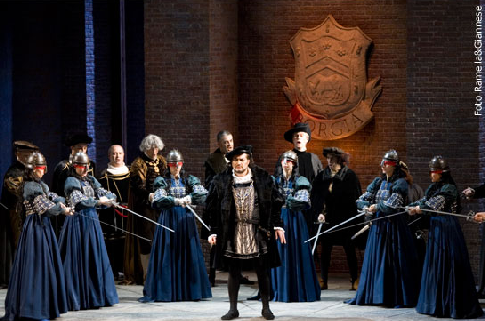 A scene from Act I
A scene from Act I
To his credit, even though he did not greatly illuminate it, Signor Bellotto also did not get in the way of the sense of the story. However, there was a "mysterious" young girl who covers the sleeping "Gennaro" with a red cloth in Act I, then is carried on dead with grieving parents in tow in Act II (ignored by all on stage), reappearing with the family in Act III to block "Lucrezia's" way as she seeks to get help for the poisoned "Gennaro," the girl later covering his corpse with the same red cloth. (Ooooooooooh)
Okay, do you get this? 'Cause I don't. Who are they? And do our characters see them? Or not? Here today, gone domani? A consistent point of view might have yielded a good dramatic device instead of another minor distraction.
Happily, on the musical side, Torino's forces delivered the goods. I originally went planning to see Fiorenza Cedolins in the Sunday matinee, only to find she had been replaced. (I didn't ask. This is Italy.) So, I opted to swap the ticket for Saturday evening (can you imagine doing that at the Met?!) to hear another soprano I have read a lot about: Angeles Blancas Gulin. And I was quite glad I did.
Up front, the lovely Ms. Gulin's singing will not please all tastes. I have the feeling that, like the great Scotto, she has a full lyric instrument with good point, that she is pushing to the limit, albeit often with thrilling results. A beat crept into a few of the very top notes, and while she did nail a climatic note in-Alt at Act I's end, we (and she) might have been happier with a lower option.
But she is indisputably a creature of the stage, prowling and hissing, sparking and ranting, singing alternately with controlled beauty, hushed introspection and inflamed dramatic declamation. Her impassioned portrayal earned her a huge ovation, and ultimately she won me over and took me along on her journey owing more to her total commitment and musicianship than to her overall vocal production. Still, it is a rare treat to hear the piece, and a joy to hear the role embodied so thoroughly.
Tenor Salvatore Cordella ("Gennaro") was a stand-in for Raul Hernandez, also not singing as announced (see above, this-is-Italy-don't-ask-don't-tell). Mr. Cordella has a sweet voice deployed with a sound technique, and he husbanded his resources well. However, there is a difference between sensible pacing, and marking. And I felt our tenor was so croony on so many passages that he gave the impression of feeling over-parted, scaling back on the parlando passages so he could pour out the tone convincingly on the money sections. A young man, experience may remedy this effect and even out his vocal portrayal.
No such problem from our "Don Alfonso," Simone del Savio. He is possessed of a very substantial, warmly engaging baritone that has even production throughout, admirable portamento, and plenty of presence. If the top notes didn't quite rattle the chandeliers like Milnes or MacNeill, they were nevertheless well-focused and full-voiced.
Arguably, the vocal performance of the night was the knock-out turn by Barbara di Castri as "Orsini." From the first time she opened her mouth and let fly with a phrase in chest voice that would have made Horne proud, this was announcement of a major talent. It is true that she sang "just" under the pitch in some of Act I's higher reaches, but this vanished completely in the remainder of the piece, as she claimed the stage at every moment with a well-sung, committed portrayal of great power and vocal beauty.
The resident orchestra was in fine form under the sure hand of veteran Bruno Campanella. Hearing these pieces played by Italians is most always a revelation to me. They seem to effortlessly embrace this style, bringing fire, artistry and excitement to even the most simplistic of melodic phrases, and to the most trite of predictable rhythmic effects. More important, Maestro Campanella and his band partnered their soloists with care and sensitivity.
Overall, then this outing offered compelling music-making, excellent production values, and non-offensive staging. While Act I of "Lucrezia Borgia" may still fail to excite me, a musical reading as persuasive as this could convince me to give it yet another listen. And with some loving attention to character relationships, Torino could transform this "Lucrezia" from merely a very good evening into a truly memorable night at the opera.
James Sohre
image=http://www.operatoday.com/08_lucrezia_05l.png image_description=Dimitra Theodossiou (Lucrezia Borgia) product=yes product_title=Gaetano Donizetti: Lucrezia Borgia product_by=Teatro Regio di Torino product_id=Above: Dimitra Theodossiou (Lucrezia Borgia)Photos courtesy of Fondazione Teatro Regio di Torino
April 18, 2008
Composer Philip Glass charms in Nasher Salon lecture
 By SCOTT CANTRELL [The Dallas Morning News, 18 April 2008]
By SCOTT CANTRELL [The Dallas Morning News, 18 April 2008]
No other composer has made as long and lucrative a career out of so modest a bag of tricks as Philip Glass. For four decades, his diddle-diddles and doodley-doodlies have transported some and maddened others. But predictions of his imminent demise have proved unfounded.
Review: Ainadamar, Flavio and Der Rosenkavalier
 [Daily Telegraph, 18 April 2008]
[Daily Telegraph, 18 April 2008]
Rupert Christiansen reviews Ainadamar and Flavio at the Barbican and Der Rosenkavalier performed by Zurich Opera at Festival Hall
Born into an East European Jewish family, brought up in Argentina, and educated in Israel and the US, the composer Osvaldo Golijov wasn't destined to fit neatly into a mould. In the US, his eclecticism has won him widespread popularity, but what precisely underpins it?
The Minotaur: Enthralling, hypnotising - and unloveable
 Rupert Christiansen [Daily Telegraph, 17 April 2008]
Rupert Christiansen [Daily Telegraph, 17 April 2008]
Ever since the story went round that Benjamin Britten had stormed out of the premiere of his first opera, Punch and Judy, Harrison Birtwistle has been cast as the bogeyman of modern music theatre, associated with a brutalist aesthetic infatuated with monsters, myths, masks, mime, murder and mayhem.
April 17, 2008
Bringing Out the Big Gunns
 By JAY NORDLINGER [NY Sun, 17 April 2008]
By JAY NORDLINGER [NY Sun, 17 April 2008]
Nathan Gunn is a baritone, famous for taking his shirt off in opera productions. (He is famous for being a very fine singer and singing actor, too.) Julie Gunn — or “Dr. Julie Gunn,” as she is known in her bio — is his wife and a pianist. They often give recitals together, and they gave one at Zankel Hall on Tuesday night. It was an exceedingly unusual recital.
Kathleen Battle, Carnegie Hall, New York
 By Martin Bernheimer [Financial Times, 15 April 2008]
By Martin Bernheimer [Financial Times, 15 April 2008]
Understatement: Kathleen Battle has had an unusual career.
In 1994 she was at the peak of her powers, a lyric-coloratura of uncommon refinement, intelligence and charm. Though small, her silver-bell soprano was perfectly focused. She deserved her place as an international star attraction. Her backstage image, however, seemed less benign. Colleagues reportedly endured outrageous prima-donna indulgences and ego tantrums. Joseph Volpe, macho head of the Met, made a public point of firing her before a revival of La fille du régiment. She never returned to opera.
April 13, 2008
MASSENET: Le Cid
Music composed by Jules Massenet. Libretto by Adolphe d’Ennery, Edouard Blau and Louis Gallet based on Le Cid (1637) by Pierre Corneille.
First Performance: 30 November 1885, Opéra, Paris.
| Principal Characters: | |
| Chimène, daughter of Count Gormas | Soprano |
| L’Infante, Daughter of Don Fernand | Soprano |
| Rodrigue (Le Cid) | Tenor |
| Don Diègue (Don Diego), father of Rodrigue | Bass |
| Le Roi, Don Fernand, King of Castille | Baritone |
| Le Comte de Gormas (Count Gormas) | Bass |
| Sr. Jacques | Bass |
| L’Envoyé Maure | Baritone |
| Don Arias | Tenor |
| Don Alonzo | Baritone |
Setting: Eleventh Century Burgos, capital of Castille.
Synopsis:
Rodrigue has returned from victory over the Moors, and the first act shows him receiving knighthood from King Ferdinand, at the house of Count Gormas, whose daughter, Chimène, is in love with the warrior. The King and his family approve, although the King’s daughter herself loves Rodrigue. The latter match, however, is impossible since the hero is not of royal blood. The King bestows upon Don Diego, father of Rodrigue, a governorship expected by Count Gormas. The enraged Count insults Don Diego, who, too old to fight, calls upon his son to uphold his honor—without naming his adversary.
Although grieved upon learning his adversary’s identity, Rodrigue is obliged to go through with the duel, and more by accident than design kills the Count. Chimène swears vengeance.
The next scene takes piace in the great square before the palace of the King at Seville, where a crowd of merrymakers has gathered, for this is a festival day. In the midst of the revelry Chimène appears and begs the King to bring revenge upon Rodrigue. The King refuses, and learning that the Moors are advancing, bids her delay her vengeance until the close of the campaign, for Rodrigue is to lead the Spanish forces. Before departing, Rodrigue gains an interview with Chimène, and finds that her love is as strong as her desire for retribution.
At first seemingly near defeat, Rodrigue prays and resigns his fate to Providence. Then there is a sudden turn of fortune and the Spaniards are victorious.
First reports come that the army has been defeated and its leader slain. Chimène has her revenge, but is prostrated with grief and fervently declares her love. A second report reverses the news and Rodrigue returns to find his beloved still implacable. The King, shrewdly enough, now promises Chimène he will punish the warrior, but Solomon-like asks her to pronounce the death sentence. This unexpected decision causes her once more to change her mind, and when Rodrigue draws his dagger and threatens to end his own life if she will not wed him, she is compelled to acknowledge that Love is triumphant.
[Synopsis Source: The Victor Book of the Opera (10th ed. 1929)]
Click here for the complete libretto.
image=http://www.operatoday.com/Cid_El.png image_description=El Cid audio=yes first_audio_name=Jules Massenet: Le Cid first_audio_link=http://www.operatoday.com/LeCid1.m3u product=yes product_title=Jules Massenet: Le Cid product_by=Rodrigue (Chris Merritt), Chimène (Michèle Command), L'Infante (Maryse Castets), Don Diègue (Jean-Philippe Courtis), Don Gormas (Gabriel Bacquier), Patrick Fournillier (cond.), Massenet Festival, Opéra Théâtre de Saint-Étienne, 1994April 11, 2008
Tenor Giordani Sings for Pope at Yankee Stadium: Interview
 Interview by Manuela Hoelterhoff [Bloomberg.com, 11 April 2008]
Interview by Manuela Hoelterhoff [Bloomberg.com, 11 April 2008]
April 11 (Bloomberg) -- Marcello Giordani, an unusually tall and hardy tenor, just finished a surprising season at New York's Metropolitan Opera, where he subbed for frail little colleagues while shining in his own shows.
'Candide' Shows Its Age
 By GEORGE LOOMIS [NY Sun, 11 April 2008]
By GEORGE LOOMIS [NY Sun, 11 April 2008]
One of Beverly Sills's landmark achievements as general director of New York City Opera was the company's 1982 production of Leonard Bernstein's "Candide." It wasn't that Harold Prince's production was particularly outstanding, though it was well received. Rather, the achievement was that it marked the first staging of this famously problematic work, originally seen on Broadway in 1956, that presented Bernstein's score in a reasonably full version and that won critical and popular acclaim.
L'opéra passion
 Serge Martin [lesoir.be, 11 April 2008]
Serge Martin [lesoir.be, 11 April 2008]
Elle fut la Violetta de La Traviata à la réouverture de la Fenice, à Venise, et incarna Lucia di Lammermoor dans la mémorable production des Chorégies d'Orange, retransmise par France 3. Patrizia Ciofi appartient désormais au gratin du chant mondial. A partir de ce 30 avril, elle sera la Maria Stuarda de l'opéra éponyme de Donizetti à l'Opéra royal de Wallonie, dans une mise en scène de Francesco Esposito et sous la direction de son mari, Luciano Acocella. Mais profitant de sa présence à Liège pour les répétitions, la soprano italienne nous offre, ce samedi, un superbe récital.
Feisty Orchestra Fuels Brussels Opera Changes
 Commentary by Shirley Apthorp [Bloomberg.com, 10 April 2008]
Commentary by Shirley Apthorp [Bloomberg.com, 10 April 2008]
April 10 (Bloomberg) -- Mark Wigglesworth, designated music director of La Monnaie/De Munt opera house in Brussels, won't take up his post in August as planned. The British conductor faced mounting opposition from a disgruntled orchestra.
An Improbable Opera
 (Photo: Ken Howard)
(Photo: Ken Howard)
By KATE TAYLOR [NY Sun, 9 April 2008]
When a chance came up to talk to Philip Glass about mounting a work of his at the English National Opera, Phelim McDermott jumped on it. Mr. McDermott — who runs, with Julian Crouch, a theater company called Improbable — was hardly an opera buff, but he was a huge fan of Mr. Glass.
April 9, 2008
Prokofiev's The Gambler at the MET
That version of a line from another opera I once saw at the Met expresses my initial reaction to the return of the elegant Temur Chkhedze production of Prokofiev’s The Gambler, based on the novella of addiction and social dysfunction set in a fictitious German casino spa much like the ones where Dostoevsky frittered himself into bankruptcy. In the Met production, Roulettenberg is not so much a green baize casino as a four-story-high pinball game, with great glass-and-metal towers to knock the balls back in, flashing and spinning, lights, exploding horses and fireworks, a twirling park for the characters to circle each other when not “in play,” and a crannied attic – which expands to the width of the stage as needed – for our eponymous gambler to spend his time driving himself nuts with unrequited passion, for both the lovely Polina and the equally whimsical game of roulette. It’s not money he’s after, really, this Alexei slouching aggressively around town (in Vladimir Galouzine’s mesmerizing, physical, merciless star performance), or even Polina, really – it’s the thrill – of beating the odds – every sort of odds – life’s odds – the class system’s odds – the odds of Fate. Since that particular house cannot be beaten, the story cannot end well. We hardly laugh when a bankrupt, lovelorn General fires a pistol into his own head – the gun isn’t loaded and he’s already dead.
Prokofiev’s opera is not melodious, even by the standards of his War and Peace, which swept us off our feet when the Met revived it in December. The Gambler has no big picture, no nations running riot on the stage, and no glorious off-kilter waltzes to set the sensual scene. It is a lithe, onomatopoeic score, a vehicle for a few great singing actors, and the story is tightly wound. Alexei, a typical poor Russian intellectual, works as a tutor in the family of a General, who has come to Roulettenberg, supposedly to take the waters but actually to barter his lovely stepdaughter, Polina, to a rich marquis in order to borrow enough money to win the hand of the lovely courtesan, Madame Blanche, meanwhile hoping his rich mother-in-law in Moscow will finally die and leave him her fortune. Tragically, the old lady is in fine health, comes to town herself, and loses sixty thousand at the wheel. Polina begs Alexei to acquire the money to save her from selling herself on the marriage market, and in the spectacular set piece of Act IV, he goes to the tables, breaks the bank and cleans out the town! Triumphant, he gives the money to his adored Polina – and she hurls it back in his face. Curtain.
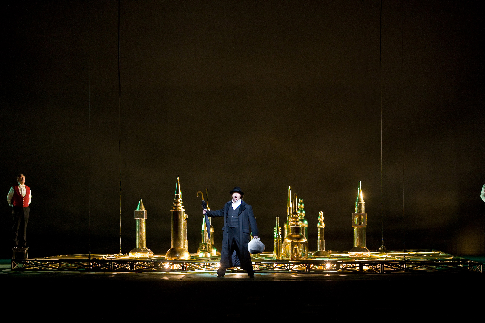 A scene from Prokofiev's "The Gambler" with Vladimir Galouzine as Alexei (center).
A scene from Prokofiev's "The Gambler" with Vladimir Galouzine as Alexei (center).
Prokofiev wisely simplified Dostoevsky’s ugly story. In the short novel, Blanche carries Alexei off to Paris to teach him how to spend (her great talent); but he enjoys nothing now except a gambler’s high, and returns to the casino a hopeless addict.
The shadiness of these figures is the point – notice that none of them are blood relations. In the 1870s, censors (and readers) would not have been able to endure a story in which people sell their children or parents for money, but stepchildren, adoptive parents and in-laws were fair game. Even forty years after the novel appeared, when Strauss, in Elektra, showed a family of blood relations hating each other, there was a scandal. Then Freud let the cat out of the bag about families.
The Met’s brilliantly staged, magnificently played, sparsely attended revival is the swan song of Valery Gergiev’s immensely distinguished far too brief career as the Met’s co-music director, a period that has introduced us to many wonderful, too-little-known Russian works with the cream of Russian singers and a mixed bag of Russian directors to put them over. It will immensely impoverish the Metropolitan, and the New York opera scene (thickly inhabited with Russians these days, by the way) if these works, and others we have not yet heard, vanish from the repertory and we resume mediocre revivals of the thrice-familiar.
Promenading about George Tsypin’s glamorous set these days (thrillingly lit by James F. Ingalls), besides the extraordinary Mr. Galouzine, who plays a crazed Russian as if he were, well, a crazed Russian (he’ll do it again in Pikovaya Dama next year, and you know? in Pagliacci, he was the scariest Canio I’ve ever seen); Olga Guryakova’s plum-shaped, sensuous tones as Polina; Larissa Diadkova as a far livelier (and audibly far easier to take) Grandma than Elena Obrastzova was; and a great horde of Kirov and Met regulars in smaller roles doing small but exciting things. This is one of those operas where one is very thankful for the Met titles, as we would otherwise miss a lot even if we were fluent in Russian (and I’m not).
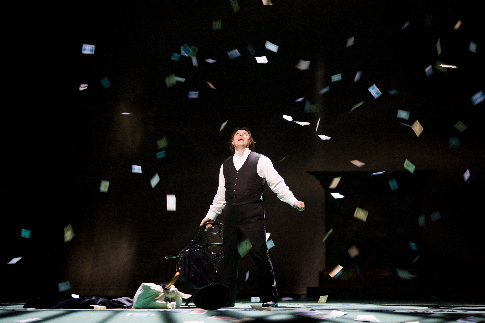 A scene from Prokofiev's "The Gambler" with Vladimir Galouzine as Alexei.
A scene from Prokofiev's "The Gambler" with Vladimir Galouzine as Alexei.
An evening of theater at the Met that will wake you up.
John Yohalem
Click here for The Gambler by Fyodor Dostoevsky
image=http://www.operatoday.com/GAMBLER_Guryakova_as_Olga_2408.png image_description=Olga Guryakova as Polina in Prokofiev's "The Gambler." Photo: Marty Sohl/Metropolitan Opera--Photo from the final dress rehearsal on March 24; 2008 at the Metropolitan Opera in New York City. product=yes product_title=Sergei Prokofiev: The GamblerMetropolitan Opera, performance of 31 March 2008 product_by=Alexei: Vladimir Galouzine; Polina: Olga Guryakova; Grammy: Larissa Diadkova; Blanche: Olga Savova; General: Sergei Aleksashkin; Marquis: Nikolai Gassiev; Mr. Astley: John Hancock. Conducted by Valery Gergiev.
Production by Temur Chkhedze; sets by George Tsypin; lighting by James F. Ingalls; costumes by Georgi Alexi-Meshkishvili product_id=Above: Olga Guryakova as Polina
All photos by Marty Sohl/Metropolitan Opera
April 8, 2008
KUMMER: Cello Duets
Friedrich August was a cellist, a student of Dotzauer; another member of the family was Kaspar (or Gaspar), a prolific composer for the flute.
The disc of selected duets from Friedrich August (items from op. 22, op. 103, and 0p. 156) recorded by cellists Phoebe Carrai and Tanya Tomkins, on period instruments, is simply lovely. The sound is rich and warm, without being strident, and the music is lyrical, romantic, while retaining some of the restraint of the classical era. Such attractive works for duo are rare (another example might be the Offenbach duos for the same combination), and the performances are top-notch (not surprising, given that Carrai played for years with Reinhard Goebel). Not just for string-players, but for all music-lovers.
Tom Moore
image=http://www.operatoday.com/Kummer_cello_duets_AV2060_1.png
image_description=Friedrich August Kummer: Cello Duets
product=yes
product_title=Friedrich August Kummer: Cello Duets
product_by=Phoebe Carrai, Tanya Tomkins, cellos
product_id=AVIE 2060 [CD]
price=$16.49
product_url=http://www.arkivmusic.com/classical/Name/Friedrich-August-Kummer/Composer/6674-1
Frankurt Opera — The Rape of Lucretia
Britten wrote this complex chamber opera after his large-scale masterpiece “Peter Grimes” and it could not be less alike, not only in scale, but in the method of storytelling. For “Lucretia” is a concept work from the get-go, a tale of violent criminal sexual behavior in ancient Rome juxtaposed with a narration and commentary characterized by Christian proselytizing from a solo “Male and Female Chorus,” one each.
Peripatetic baritone Dale Duesing, while still performing well himself, has been venturing into stage direction in the early autumn of his vocal career, and he has come up with a stunning solution in which to frame the piece. He made the two “Chorus” soloists insidiously engaging televangelists, and the clean and effective “pure” white stage setting (by Boris Kudlicka) their TV studio set. Indeed, the effect would not have been out of place on the Praise the Lord Network.
Like a PTL pre-show, the “ministers” mingled with and greeted the real life audience, and the rest of the cast/production team joined them onstage for a prayer circle before the telecast began. A video cam was used selectively throughout with telling effect, sometimes creating a TV show atmosphere, sometimes manipulating its target worshipers with calculated inspirational imagery, but often as not capturing characters in the cross hairs of emotional flash points with a chilling freeze frame effect.
As the enactment of “Tarquinius’” pre-meditated, unutterably evil ravishment of “Lucretia” unfolded (as played by the TV “cast”), the line between an elusive “good” and faux piety began to blur inexorably. It was soon hard to reconcile ugly reality with pious posturings, which indeed initially reveled in re-telling this sordid tale as something merely to be rather salaciously exploited for moralizing effect. As the whole scenario careened out of anyone’s control it morphed into a profound spiritual tragedy which would not be soothed away by empty religious platitudes of convenience. When the “moral” televangelists are as spiritually bankrupt as the godless “Tarquinius,” to whom does one turn for succor? (Stop me if this sounds familiar. Jerry? Tammy Fay? Oral?)
This compact two-acter crams a lot of provocative imagery into its rather short running time: The ravishment of innocence. Radical religious pronouncements. Exploitation of power. Objectification of women. Political one upsmanship at any cost. Mindless degradation of a perceived rival. Military misdeeds. All this in a piece penned in 1956. Find any contemporary resonance here? Let’s see a show of hands. . .
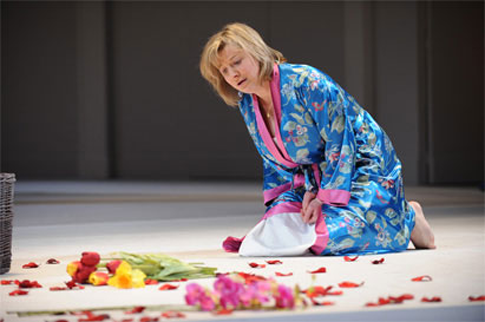 Claudia Mahnke (Lucretia)
Claudia Mahnke (Lucretia)
In addition to his shatteringly correct concept, Mr. Duesing not only showed a refined skill for varied and meaningful blocking, but more important, he coaxed highly individual and deeply internalized characterizations from a uniformly excellent ensemble of singers, cast from strength. A sure directorial hand infused the piece with a palpable tension building to the titular act of uncommon menace, brutality, and pre-meditation.
The largest ovation of the night was earned by baritone Andrew Ashwin for a top notch reading of “Junius.” This young performer, with his robust, focused voice and a strapping presence, seems on the verge of a major career. Simon Bailey’s sympathetic demeanor and warm, burnished tone brought dignity and compassion to “Collatinus.”
The lovely young lyric soprano Krenare Gashi served Britten’s high-flying leaps and turns with spot-on precision in a wholly engaging turn as “Lucia.” She was matched in artistry and stage presence by the plummier mezzo of Arlene Rolph as “Claudia.” Their extended bucolic duet scene “the morning after” was immaculately voiced. Nathaniel Webster was a fine “Tarquinius,” and not of the mere “eye candy” variety that other recent star singers have brought to the part. Mr. Webster not only sang with force and beauty throughout, but he can also color and declaim his threats with a biting urgency, and even sexual huskiness. His uninhibited, disrobed physicalization of “the deed” was powerful stagecraft.
As the “Chorus,” Anja Fidelia Ulrich and, especially, Peter Marsh were frighteningly focused on their “mission,” as grinning disingenuous money lenders who needed to be driven from the temple. (Where’s a Messiah when you need one?) Although I have always found the “Female Chorus” to be less interesting musically, Ms. Ulrich certainly sang it well, and found plenty to work with dramatically as her character arguably became the most sympathetic onlooker in the the tragedy. Only she appeared to realize what they, and God had wrought in setting this tale in motion. Mr. Marsh seemed born to sing his role. Part snake oil salesman, part brain-washed believer, his characterization was disturbingly well-rounded, and as well sung as you are likely to hear.
That leaves our heroine, and Claudia Mahnke created a noble heroic figure, pitying and pitiable, strong-willed yet accepting of her fate in a way similar to the young wife in the recent film “No Country for Old Men.” Confronted with consummate evil, she knows why “Tarquinius” is there, and is helplessly doomed to be his prey. Whether singing full tilt or scaling down to a whisper, this splendid house mezzo deployed her smoky-hued voice to full effect in sculpting a multi-faceted portrayal. Her defiled appearance before her husband in purple gown (just one of Nicky Shaw’s excellent costumes), and subsequent slitting of her wrists ending in a bloody death on the flower-strewn, lit white steps in a crucifixion pose, was just one more chilling image in an evening filled with visual artistry.
The chamber orchestra under Maurizio Barbacini could hardly have been bettered. Soloists all, they relished their individual moments as virtuosically as they essayed the concerted ensemble efforts. Britten’s harp effects always strike me afresh as magical calculations, and his masterful scoring was well served by the skilled Frankfurt instrumentalists.
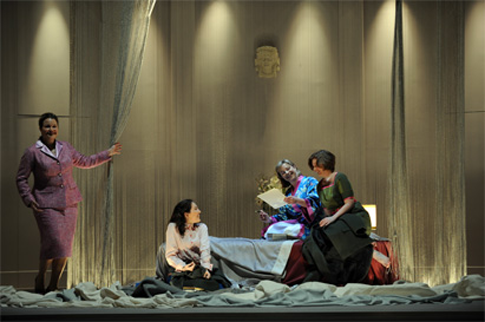 Anja Fidelia Ulrich (Female Chorus), Krenare Gashi (Lucia), Claudia Mahnke (Lucretia), Arlene Rolph (Bianca)
Anja Fidelia Ulrich (Female Chorus), Krenare Gashi (Lucia), Claudia Mahnke (Lucretia), Arlene Rolph (Bianca)
As true testament to the success of “The Rape of Lucretia,” not only were there waiting lines for ticket returns for each show (for “Lucretia” of all things!), but I cannot remember the last time I was a member of an audience that was so still, so engaged, so attentive to every phrase, every musical utterance. Honestly, the promise of thrilling evenings like these is why I continue to go to the opera.
Suffice it to say if this is an example of Dale Duesing’s directorial skill, I may have to become a groupie. And Frankfurt should seriously consider reviving this splendid production, a triumph for all concerned. Bravi tutti!
James Sohre
image=http://www.operatoday.com/lucretia11.png image_description=Peter Marsh (Male Chorus), Nathaniel Webster (Prince Tarquinius) [Photo: Barbara Aumüller] product=yes product_title=Benjamin Britten: The Rape of LucretiaOper Frankfurt product_by=Male Chorus (Peter Marsh), Female Chorus (Anja Fidelia), UlrichCollatinus (Simon Bailey), Junius (Andrew Ashwin), Prince Tarquinius (Nathaniel Webster), Lucretia (Claudia Mahnke), Bianca (Arlene Rolph), Lucia (Krenare Gashi) product_id=Above: Peter Marsh (Male Chorus), Nathaniel Webster (Prince Tarquinius)
All photos by Barbara Aumüller
April 7, 2008
Barenboim and Berlin — beauty and brilliance
No one remembers, for today — if lines at airport counters are an indication — the two are neck and neck with both doing well. Their competition comes to mind, however, here in Berlin, where the Philharmonic, looking back on golden ages under Wilhelm Furtwängler and Herbert von Karajan, has long been the No. 1 orchestra not only here, but — in the eyes of many — in the whole world. In the long-divided city the Staatskapelle, on the other hand, attracted little attention in its primary role as the competent but colorless pit band in the historic Staatsoper on Unter den Linden in the East. Then — in 1989 — the Wall came down, and — in 1992 — Daniel Barenboim was made maestro of the opera and its orchestra.
 Daniel Barenboim
Daniel Barenboim
A week in the city over Easter underscored his success in bringing to both a brilliance that declares them no longer No. 2 to anyone. Easter is, of course, the time for Barenboim and his forces to shine, for the Philharmonic and its charismatic conductor Simon Rattle are off in Salzburg for the spring festival that Karajan founded there. Barenboim performances are the heart of the local “Festtage,” a mini-festival instituted even before the Wall was built to attract audiences to the East.
On March 16 Barenboim kicked off the series at the Staatsoper with the first Berlin staging of Prokofiev’s “The Gambler,” a torrid tale of love and the loss of fortunes based on Dostoyevsky’s 1866 novella that reflected the author’s own addiction to gambling. In an eye-catching updating by Dmitri Tcherniakov, responsible also for sets and costumes, gamblers were on stage in fictional Roulettenburg even before the music began. Prokofiev went to work on “Gambler” in 1915 when he was 24. A first version was slated for production in St. Petersburg, but cancelled when street fighting heralded the revolution. Plans for a Russian staging were later scrapped because the composer was living abroad. The opera — revised in 1927-‘28, was premiered in Brussels in 1929 and has had only a handful of stagings since then. (It played at the Chicago Lyric Opera in 1991.) This made the production at the Staatsoper, where Barenboim is cherished above all for his work with Mozart and Wagner, an event of special interest, and — with best seats selling at 260 Euros (around $400) — the historic house was packed.
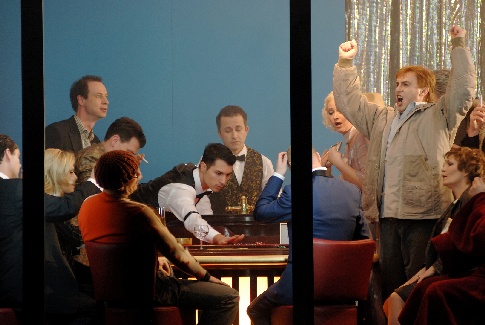 Scene from The Gambler
Scene from The Gambler
Conductor and orchestra had fully mastered Prokofiev’s chrome-plated score, which with its sharp edges and abrupt corners recalls that “Gambler” is the contemporary of Berg’s “Wozzeck.” The work’s study of a society sick to the depths of its soul is of obvious contemporary relevance. Largely through-composed, “Gambler” gives primacy to the text — sung here in Russian with titles in German, and for it Barenboim assembled a cast of two dozen that was without a weak link. Christine Opolais was stellar and sympathetic as Polina, a young newly rich woman unable to believe that a man could love her without selfish goals, and as that young man Misha Didyk was a dramatically overwhelming Alexej. Outstanding were two character roles: Stefania Toczyska as the matriarchal Babulenka who gambles away jewels and furs to stand figuratively naked before false gods, and bass Vladimir Ognovenko as the equally depraved General. “Gambler” tells a dark and threatening story. Barenboim and his ensemble told it with conviction.
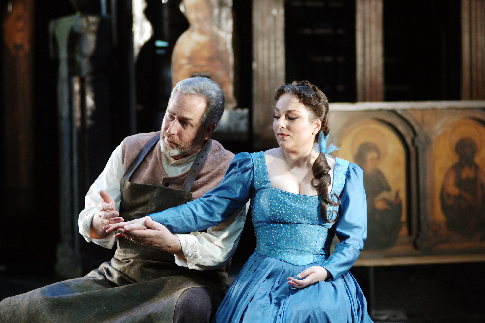 Scene from Die Meistersinger: James Morris (Hans Sachs) and Dorothea Röschmann (Eva)
Scene from Die Meistersinger: James Morris (Hans Sachs) and Dorothea Röschmann (Eva)
Barenboim was back on the podium on Palm Sunday to conduct Harry Kupfer’s stunningly colorful production of that most German of all operas, “Die Meistersinger,” and it was on this familiar Wagnerian turf that the he and the Staatsoper were of truly unsurpassable excellence. In his sensitive approach to the Overture Barenboim made voices audible that one had never heard before, and the pathos-ridden Prelude to Act Three, often tossed aside unthinkingly en route to the pageantry of the final scene, was gripping in its bitter sweetness.
In his house debut James Morris, the reigning Wotan of his generation, was touchingly convincing as Hans Sachs, Wagner’s shoemaker torn between his own love for Eva and his support for young Walter in his efforts to break the ossified rules of the master minstrels. Morris played an understated Sachs and was in even smoother and richer voice here than he was for his debut in the role at the San Francisco Opera in 2001 and in the DVD that originated at the Met the following season. Dorothea Röschmann, a Mozartian now moving into lighter Wagner roles, sang Eva with ease and clarity, while Burkhard Fritz was a Walter of often bashful youth. Among the masters Rene’ Pape stood out as an aristocratic Pogner, and Roman Trekel was a handsome — if pedantic — Beckmesser, who avoided clichés of self-parody. And while David and Magdalene are roles often assigned to singers on the eve of retirement, it was refreshing to hear them sung — and sung well — by youthful Florian Hoffmann and Katharina Kammerloher. Yet it was Barenboim who made these two evenings a triumph of perfection. Everything spoke of immense care and concern for the task at hand. And it was a nice touch that Barenboim brought the entire orchestra on stage for a curtain call at the end of “Meistersinger.”
To fully appreciate the excellence of the Staatskapelle, however, one must hear them out of the pit in concert. On March 20 Barenboim took the orchestra to the Philharmonic Hall, Hans Scharoun’s 1963 masterpiece that is beyond doubt the world’s most successful — and beautiful — concert venue. There one witnessed the interaction of Staatskapelle musicians and experienced how closely “in sync” they are with Barenboim. Highlight of the program was Brahms’ D Minor Concerto, played by Lang Lang, today’s sensation among young pianists.
One doubted a few years ago whether the Chinese-born pianist would be able to handle the success that he was, but today it is happily clear that at 25 he has found himself and is headed towards even greater things in the future. Here, again, however, Barenboim deserved much credit for the experience that this was. Long a master among pianists, he know this concerto inside and out, and it was fascinating to watch — and hear — him guide his orchestra through it. This was conducting as it should always be: instructive, shaping and forming — recreating, in short, the piece at hand. It was evident that he and Lang Lang had worked together carefully to make this a memorable performance.
Barenboim, in sum, is one of today’s great artists, and his influence and impact are felt far beyond Berlin. He is the man who broke the Israel taboo on Wagner by conducting the Prelude and “Liebestod” from “Tristan” as an encore there in 2001 — to near-violent reaction from many in the state. He worked with Palestinian scholar Edward Said to found the West-Eastern Divan, an ensemble of young musicians from countries throughout the Middle East that is now of legendary fame. A citizen of Israel, he has now acquired Palestinian citizenship as well.
*******
A note on the Berlin Staatsoper. The building, built originally in 1740 by Friedrich the Great and destroyed and rebuilt many times since then, is in a horrid state of disrepair. Walls are dirty and cracked; carpets are threadbare and floor creak. The building is scheduled to close in 2010 for three years of reconstruction to cost some $260 million.
Wes Blomster
image=http://www.operatoday.com/Gambler_01.png image_description=Christine Opolais (Polina) and Misha Didyk (Alexej) product=yes product_title=Sergei Prokofiev: The Gambler product_by=Above: Christine Opolais (Polina) and Misha Didyk (Alexej)All production photos by Monika Rittershaus courtesy of Staatsoper Unter den Linden
April 6, 2008
A Rising Star in L.A. Opera’s Young Artist Program
 By Laurie Winer [LA Times, 6 April 2008]
By Laurie Winer [LA Times, 6 April 2008]
When she was born, Angel Joy Blue's father, Sylvester Blue, held her up and noticed that she had a big upper chest and a good pair of lungs. "This is the next Leontyne Price," he said, or at least that's what family lore says he said.
ANNA BOLENA – English Touring Opera
In a climate in which bel canto opera seems to be enjoying a steady and welcome revival, ETO opened their current season with a welcome production of Donizetti's historically dubious account of the latter days of Anne Boleyn. The company's fine Maria Stuarda three years ago is still fresh in the memory, and one wonders whether the company might be brave enough to complete the 'set' with a staging of Roberto Devereux before too long.
The basic framework of Soutra Gilmour's versatile set serves all three productions on the current tour, and for this opera the set's skeleton had tapestry panels mounted upon it which slid in and out of place to create different spaces and enable characters to conceal themselves from one another.
In the title role, Julie Unwin grew in confidence and vocal security as the evening progressed – at the start her tone, dynamics and vibrato overpowered the musical line a little, but by the middle of the first act she had settled into it and she gave a particularly convincing performance in the lyrical moments of the later scenes.
She was, however, overshadowed by outstanding performances from two colleagues: Julia Riley's Jane Seymour was rich-voiced, elegant, poised, passionate and credible – and although Luciano Botelho's dryish tenor is not quite beautiful, he made almost effortless work of Lord Percy's stratospherically high-lying passages. I suspect that this is one of those roles which, when sung even half-decently, is guaranteed to bring the house down – however Botelho really did deliver it with style and panache.
In fact, while most ETO offerings boast one or two particularly strong performances, I forget the last time they fielded such a strong all-round cast. Former ENO principal Riccardo Simonetti was a commanding Henry VIII, while Jonathan Pugsley's Lord Rochford and Serena Kay's Smeaton were also luxuriously sung.
Performing in an orchestration which suits the forces available (and with several cuts to the score) the company has put together a fine orchestra this time around, too, with some particularly good woodwind – Michael Lloyd conducted.
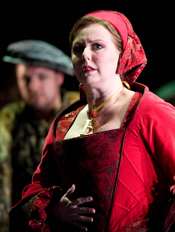 Julie Unwin
Julie Unwin
ETO's decision to perform in the original Italian – a rare exception to their usual English-language policy – was perhaps a wise one, as this repertoire benefits from the Italian vowel sounds combined with the bel canto melodic lines. However the scrolling surtitles were laughable, full of misspellings and oblivious to what might unintentionally cause amusement. But overall this is a creditable account of an opera which has been unjustly neglected in the country from which it takes its inspiration.
Ruth Elleson © 2008
image=http://www.operatoday.com/bolena_020.png image_description=Anna Bolena (ETO) product=yes product_title=Gaetano Donizetti: Anna BolenaEnglish Touring Opera, 13 March 2008 product_by=Above: Julia Riley
All photos by Robert Workman courtesy of the English Touring Opera
Move over, Edinburgh
 Stuart Jeffries [The Guardian, 4 April 2008]
Stuart Jeffries [The Guardian, 4 April 2008]
Just before we enter the air-conditioned auditorium of the Emirates Palace in Abu Dhabi for a gala concert featuring three of the world's greatest opera singers, we are each handed a copy of Chopard's Happy News magazine. As the movers and sheikhs of the United Arab Emirates take their seats, I read its interview with Russian soprano Anna Netrebko. The interviewer poses questions that Paxman and Humphrys would never dare: "You are now an ambassadress for Chopard. How would you define glamour?" "Chopard jewellery really epitomises glamour," replies Netrebko, diplomatically. It's going to be a long evening.
SUSANNAH – English Touring Opera
It has been relatively well served in America in terms of stage productions, but this was its UK professional première.
It was a shame not to see the auditorium full, as it's the kind of piece which people are inclined to find 'easy'. Musically it's attractive and unchallenging, with quasi-Puccinian melodic lines combined with quasi-folk tunes. It's also a straightforward enough setting to evoke easily on a shoestring budget and with a set destined for nine different venues; the height of summer in the southern USA was conjured up most effectively with no more than a few slatted panels and a backdrop of colourful, hazy late-afternoon lighting.
James Conway's production depicted New Hope Valley as a community which is hypocritically selective of its moral battles, ready to torture a person for any hint of extramarital sexuality but tolerant of routine domestic violence and subordination of women. Most of the younger women were either carrying babies or heavily pregnant; many of them also sported black eyes and other battle-scars. Sandra Porter's hard-faced, vitriolic Mrs McLean was a fitting figurehead for a people who profess to live by the loving word of God but in practice equate unquestioning compliance with goodness and unwitting difference with moral corruption. There are echoes of Peter Grimes in the willingness of a devoutly religious congregation to turn upon and destroy an individual.
Donna Bateman gave a lyrical and vocally touching performance in the title role. For Act 2's wistful 'Come back, o summer' she created a moment of highly-charged stillness which she never quite managed to achieve in the opera's best-known aria, 'Ain't it a pretty night'. But she never quite managed to project Susannah's crucial youth and innocence, and her words became constricted and indistinct at the top end of her voice.
As her brother Sam, the American tenor Todd Wilander was powerful in both voice and presence, as was the very young-looking Sean Clayton as the backward Little Bat McLean whose false accusations under pressure from his parents are the catalyst for Susannah's humiliation, ostracism and loss of sexual innocence.
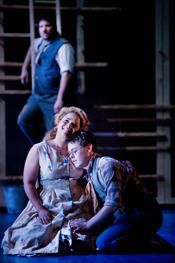 Donna Bateman (Susannah) and Sean Clayton (Little Bat)
Donna Bateman (Susannah) and Sean Clayton (Little Bat)
Andrew Slater (who returned the next evening as Mozart's Commendatore) was not particularly charismatic as the preacher Olin Blitch, but Floyd's music and director James Conway's scene-setting effectively produced an atmosphere of horrific tension in the revival meeting scene in which Susannah is put under public pressure to repent of a non-existent sin. For me, it was one of the most uncomfortable moments I can remember witnessing on a theatrical stage. Slater seemed more comfortable with the demands of the next scene, in which Blitch reveals himself as a lonely and needy person before taking advantage of Susannah at a time when she has neither the strength nor the will to resist him, and in his subsequent hopeless attempt to make right his wrongdoing.
The atmospheric lighting and attention to detail (I liked the women's sunburned shoulders) were complemented by Alexander Ingram's warm yet dramatic conducting; though occasionally the balance wasn't quite right and the singers were overpowered.
Ruth Elleson © 2008
image=http://www.operatoday.com/Donna_Bateman.png image_description=Donna Bateman (Susannah) -- ETO (Photo: Robert Workman) product=yes product_title=Carlisle Floyd: SusannahEnglish Touring Opera, 14 March 2008 product_by=Above: Donna Bateman
All photos by Robert Workman courtesy of English Touring Opera
Gheorghiu’s Big Screen ‘Bohème’
 By GEORGE LOOMIS [NY Sun, 4 April 2008]
By GEORGE LOOMIS [NY Sun, 4 April 2008]
Franco Zeffirelli’s 1981 production of Puccini’s “La Bohème” is the only Metropolitan Opera production in which the Romanian soprano Angela Gheorghiu will appear this season. But that doesn’t mean her performance won’t be widely viewed. On Saturday, the matinee performance of the production will be transmitted in HD to more than 500 movie theaters around the world.
DON GIOVANNI – English Touring Opera
The updated scenario presented the usual problems over how to deal with the plot's all-important class hierarchy, and although having the Don as a high-ranking officer went some way towards solving the problem, the idea wasn't really followed through to create a coherent structure to accommodate all the characters.
That said, it was the strongest of the three productions, directed by Jonathan Munby, and was to all intents and purposes an uncomplicated, gimmick-free staging, true to what Mozart and Da Ponte surely envisaged. The very idea of having the Commendatore in a 'statue' costume and turning up to supper seems to be oddly out of fashion these days, and tends to be passed over in favour of a bloodied reanimated corpse or a drug-induced hallucination invisible to the audience. But there indeed he was, played by the bass-baritone Andrew Slater with a presence and strength which made it easy to forget his rather youthful appearance.
Also refreshing was the casting of Jonathan Gunthorpe as a Leporello similar enough in build and looks to his master to be mistaken for him on a dark night with little suspension of disbelief. It helped that Roland Wood's Don Giovanni was played as more of a thug than a gentleman; even their voices weren't vastly dissimilar. But for the difference in the quality of their wordly goods, they were practically interchangeable, and one suspected that had Leporello been born into the moneyed aristocracy, the seeds of depravity and insatiable lust might have had the chance to germinate in him as they did in the Don.
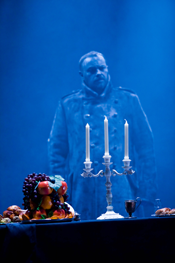
These two were vocally the strongest in the cast; all the others were serviceable, though unusually for this company there were several foreign cast members, including Eyjólfur Eyjólfsson (Don Ottavio) whose sung English was particularly difficult to comprehend. As Zerlina, Ilona Domnich also had some enunciation problems, especially at her first entrance (even though under Michael Rosewell's baton it was taken at a fairly steady pace) but she had a graceful stage presence and sang both her arias attractively and with opulent tone. Julia Spørsen's Donna Anna was an interesting creation, too, combining fragility with noble determination and steely-voiced coloratura.
The Prague version was used as the starting point with a few further cuts, and Soutra Gilmour's all-purpose framework set (shared by the other two productions on the tour) was used here to its best effect, with attractive deep blue latticed walls and backlighting.
Ruth Elleson © 2008
image=http://www.operatoday.com/giovanni_012.png image_description=Don Giovanni -- ETO product=yes product_title=W. A. Mozart: Don Giovanni product_by=English Touring Opera, March 15 2008 product_id=All photos by Robert Workman courtesy of English Touring Opera`Wozzeck' Waits on Tables, Murders Marie in Paris Staging
 Jorg von Uthmann [Bloomberg.com, 1 April 2008]
Jorg von Uthmann [Bloomberg.com, 1 April 2008]
April 1 (Bloomberg) -- ``Wir arme Leut!'' (Poor me!), sighs Marie, Wozzeck's girlfriend and eventual murder victim. So did I, facing yet another opera production by Christoph Marthaler, the frighteningly original Swiss director.
MASSENET: Esclarmonde
Music composed by Jules Massenet. Libretto by Alfred Blau and Louis de Gramont after the French romance Partonopeus de Blois.
First Performance: 14 May 1889, Opéra-Comique (Théâtre Lyrique), Paris
| Principal Characters: | |
| Emperor Phorcas | Bass |
| Esclarmonde, his daughter | Soprano |
| Parséïs, her sister | Mezzo-Soprano |
| Enéas, a Byzantine knight, fiancé to Parséïs | Tenor |
| Chevalier Roland, Count of Blois | Tenor |
| Cléomer, King of France | Baritone |
| The Bishop of Blois | Baritone |
Synopsis:
Act I
Phorcas, the Emperor of Byzantium, abdicates in favor of his daughter, Esclarmonde. He bestows upon her magical powers on the condition that she must ascend the throne alone until the end of her twentieth year. Then, a tournament will be held in which the victor will become her bridegroom. In the meantime, Esclarmonde's face must remain veiled. Esclarmonde confesses to her sister, Parséïs, to be in love with the knight, Roland. King Cléomer, however, has decided to have his daughter, Bathilde, marry Roland. Esclarmonde sends her beloved to an enchanted island, where she will seduce him. There Roland awakens in the arms of the princess. She offers to become his bride and to give him honor and glory, provided that he never discloses her identity. The next day Roland departs to Blois, which is under seige by the Saracens. Esclarmonde promises him that she will visit him every night wherever he may be. She gives him a magic sword.
Act II
Roland, victorious over the Saracens, refuses the hand of the princess Bathilde without explanation. The Bishop of Blois becomes suspicious and determines to force Roland to reveal his secret. Esclarmonde arrives that night. As the two lovers embrace, the Bishop enters and exorcizes Esclarmonde Her veil is torn off. She bids goodbye to Roland and disappears, escorted by the spirits of the fire.
Act III
Phorcas awkens his daughter and enjoins her to renounce Roland. Otherwise, he will die. Desparate, Roland enters a Byzantine tournament seeking death. Roland wins the tournament and, of course, Esclarmonde. The princess may now express her love and reveal her face.